 By Staff By Staff
April 22nd, 2020
BURLINGTON, ON
Proposed Development
A proposal has been submitted for the development of 12 townhouse blocks with a total of 83 units and three condominium townhouse blocks with 150 units. Also included in the application are a woodlot block as well as a natural heritage system (buffer) block. The proposed development has a total area of 11.1 hectares (27.2 acres). These lands are currently vacant and have been historically used for agricultural purposes.
LPAT Appeal Update – April 22, 2020
Is this progress?
At its meeting of April, 20, 2020 Burlington City Council approved the recommendation of Confidential Legal Report L-10-20 to accept an offer to settle the issues in dispute between National Homes (Brant) Inc. (“National Homes”) and the City with respect to National Homes’ appeal currently before the Local Planning Appeal Tribunal (“LPAT”).
As part of this approval, Council approved the recommendation that the planning analysis attached as Appendix ‘B’ to L-10-20 be released publicly and posted on the City’s webpage under Planning and Development Applications for Ward 1, while retaining solicitor/client privilege over the balance of this matter in its entirety.
The settlement between the City and National Homes resolves the issues in dispute between the City and National Homes on the basis that National and the City will seek LPAT approval of a revised development proposal for the subject lands.
The revised development proposes 210 dwelling units in townhouse, street townhouse, and semi-detached dwelling forms abutting public and private roadways, surrounding a 0.31 hectare centrally located Park block.
In particular, the revised development plan makes changes to where the proposed development inferfaces with the existing residential neighbourhood to the north, reducing the unit count in the area and replacing proposed 2-storey townhouses with 1.5-storey semi-detached bungaloft units. The revised development plan also increases the minimum building setback for the proposed semi-detached units backing on to existing lots on Havendale Boulevard from 9 metres to a minimum of 10 metres.
A copy of the planning analysis is available on the development application webpage, along with a copy of the conceptual site plan and proposed plan of subdivision for the revised development.
How does this impact the hearing scheduled to commence on July 27, 2020?
While the City and National Homes have settled the City’s issues in the appeal, there are two other parties to the hearing- the Region of Halton and neighbourhood association Vision 2100 Brant. As a result, the appeal hearing will proceed on July 27, 2020 with the City and National Homes attending to seek LPAT’s approval of the revised development plan and to respond to the evidence called by one or both of the other parties in opposition to the revised development.
Should the remaining parties both individually reach a settlement with National Homes in the appeal, the parties could seek to have a settlement hearing scheduled in advance of July 27, 2020 in order to present the settled plan to LPAT for approval. If that were to occur, the hearing scheduled to commence on July 27, 2020 would not be held.
The City’s development application webpage for 2100 Brant Street will be further updated to advise of any additional settlements between the other parties and National Homes or the rescheduling of LPAT hearing dates.
If the LPAT hearing proceeds, the good people in the Havendale community are going to find themselves city at a table with the city on the other side opposing what they want.
The Vision 2100 document and the delegations that were part of the protest against the development was one of the very best the Gazette has seen in the past ten years. A new city council was elected to oppose this kind of over-intensification.
It would be nice to know just how each Councillor voted on this matter in that Closed Session of Council.

 By Pepper Parr By Pepper Parr
April 22nd, 2020
BURLINGTON, ON
Anita Cassidy, Executive Director of the Burlington Economic Development Corporation gave city council and very thorough briefing on just what the commercial sector was up against.
The focus was on the hospitality and tourism sectors.
It was not a pretty picture.
 Anita Cassidy, Executive Director of the Economic Development Corporation. Cassidy reviewed just how that wave that has engulfed us got here. It all started in China last November. We have all heard the rate at which this spread and the impact it has had – what’s important at this point is to realize that this pandemic is going to change the way we do business – quite what that shape the change takes is something we will be determining.
November 2019 – First Case Wuhan China
March 14, 2020 – Burlington Parks & Rec Facilities and Agencies closed to public.
March 16 – All City Facilities closed to public,
March 17 – Ontario declared emergency and closed
• All bars and restaurants to take out only
• Schools and Childcare
• Recreation facilities, libraries and theatres
March 21 – Federal Government Closed Border to non-essential travel
March 21 – Mayor Meed Ward Declared an Emergency in City of Burlington
March 24 – Province mandated closure all non- essential businesses for 14 days.
March 30 – Province extended mandated closure all non-essential businesses until April 13.
April 3 – Province reduced list of essential businesses.
Less than three weeks and the world as we knew it had been turned upside down.
The Premier moved into overdrive and has been transparent in making information available.
Cassidy, relying heavily on Toronto Board of Trade, set out what we know and what some people expect.
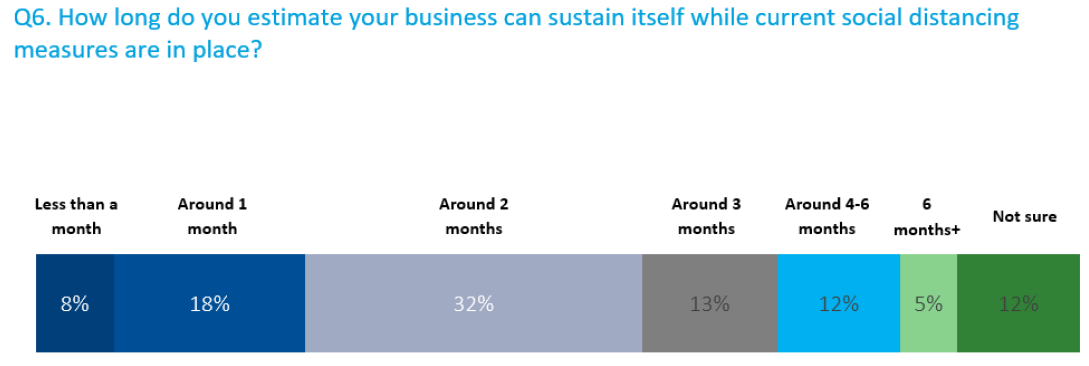 Well over half don’t think they can last more than three months.
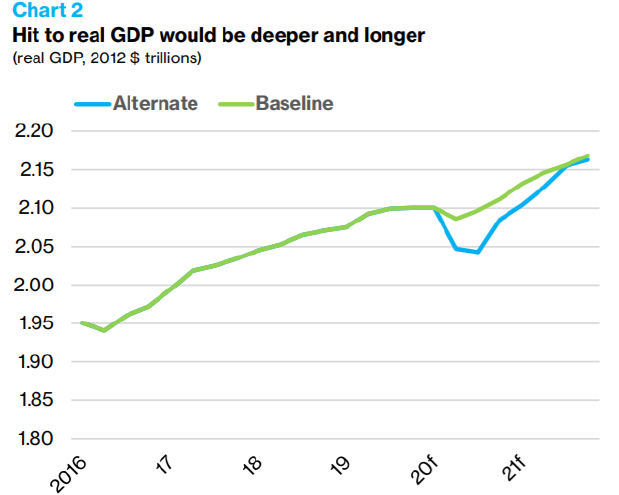
Speaking for what is being called Team Burlington – representing the Chamber of Commerce, the Burlington Downtown Business Association, the Restaurant and Hospitality group and the Economic Development Corporation Cassidy pointed to the Team Burlington COVID-19 Virtual Business Support Forum Series, a video conference series to provide businesses of all sizes with an opportunity to ask questions and hear from subject matter experts, as well as key leaders and decision-makers from all levels of government.
Business Strategy & Planning with DeGroote School of Business – April 28.
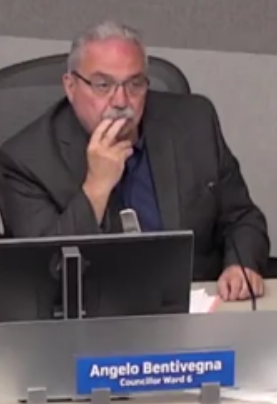 Ward 6 Councillor Angelo Bentivegna Angelo Bentivega, a small business operator and the Councillor for ward 6 asked Cassidy how council could help. “I realize,” he said “that for many of the small business owners that this is not only their business that is at risk – their major investment is also at risk.”
Everyone realizes that some operations that locked their doors three weeks ago may never get to open those doors again.
Moral support is about all the city can offer – the province and the federal government have programs – they all seem to ave strings attached to them.
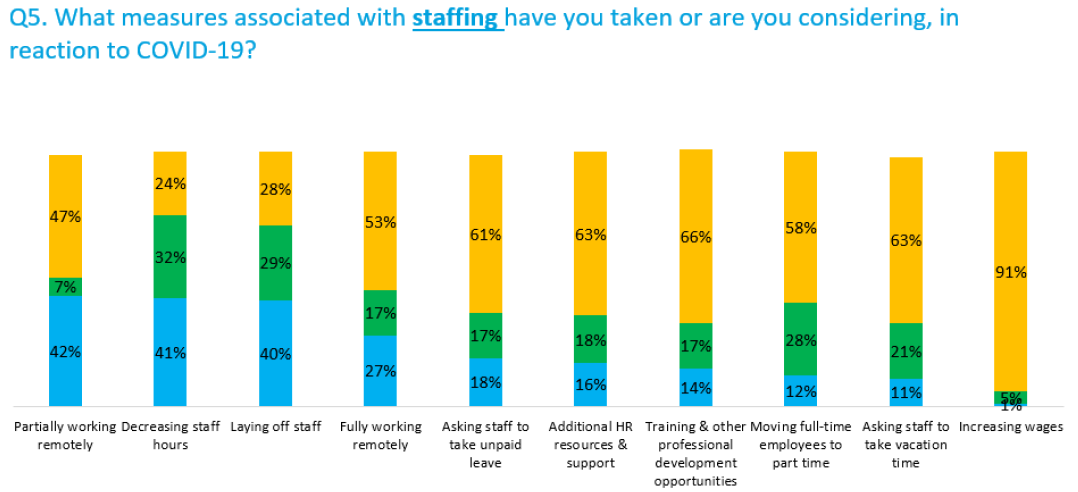
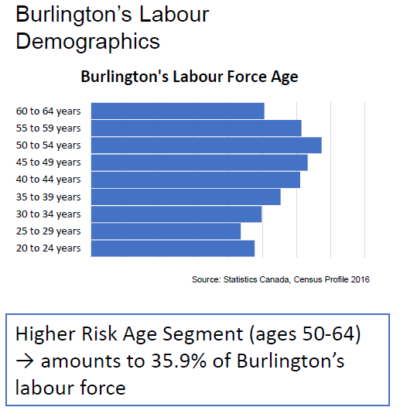
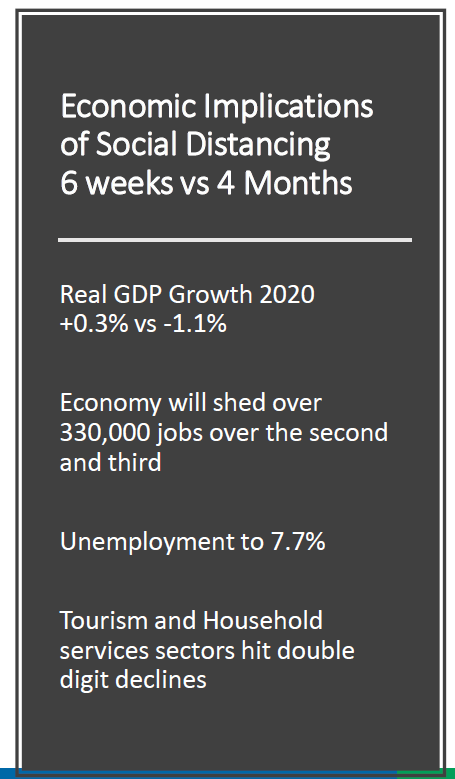

 By Staff By Staff
April 22nd, 2020
BURLINGTON, ON
Senior City staff provided an update on the financial impacts of COVID-19 to a city council that was meeting virtually. The Mayor, the City Clerk and a third person in the audio visual room were in the Council Chamber.
Council was asked to endorse a three-month strategy that prioritizes City services to be provided through to the end of June 2020 to maintain critical and essential services for the city.
Council also approved the recommendation that Committee of the Whole meetings be scheduled to help City business continue and moving forward, virtual delegations will now be allowed for members of the public at City Council meetings.
In addition, Council also approved adding an increased penalty of $250 to specific parking infractions that violate COVID-19 bylaws and orders.
Financial impacts of COVID-19
The strategic management of the City budget and finances continues to be a priority. City Council and staff remain committed to fiscal responsibility and accountability and are focused on offsetting all of the COVID-19 related City revenue losses to June 30, 2020 and are looking ahead past July 2020 to mitigate a shortfall at 2020 year-end. The City is closely monitoring and carefully managing the financial impacts of the COVID-19 emergency while at the same time ensuring taxpayers receive good value for City services that continue, as outlined in the three-month work plan.
The city expects to spend less due to facility closures, not having to pay part time workers plus a significant amount on discretionary spending. They will incur costs of $300,000 on COVID-19 costs
That story is best told in chart form.
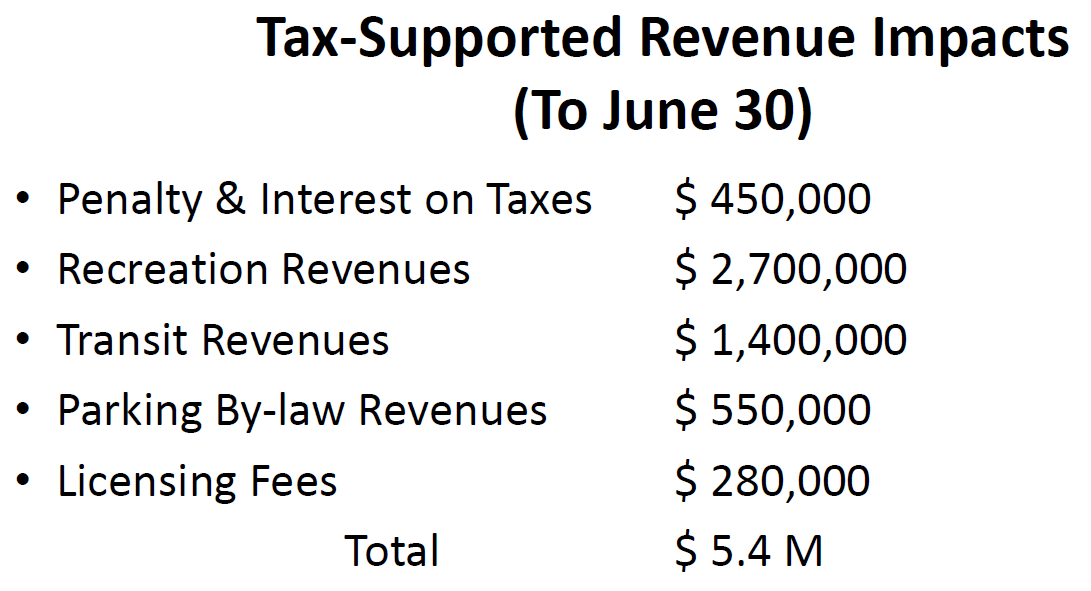 These are funds the city will not be getting due to the shut down of city hall and the closing of many of the services.
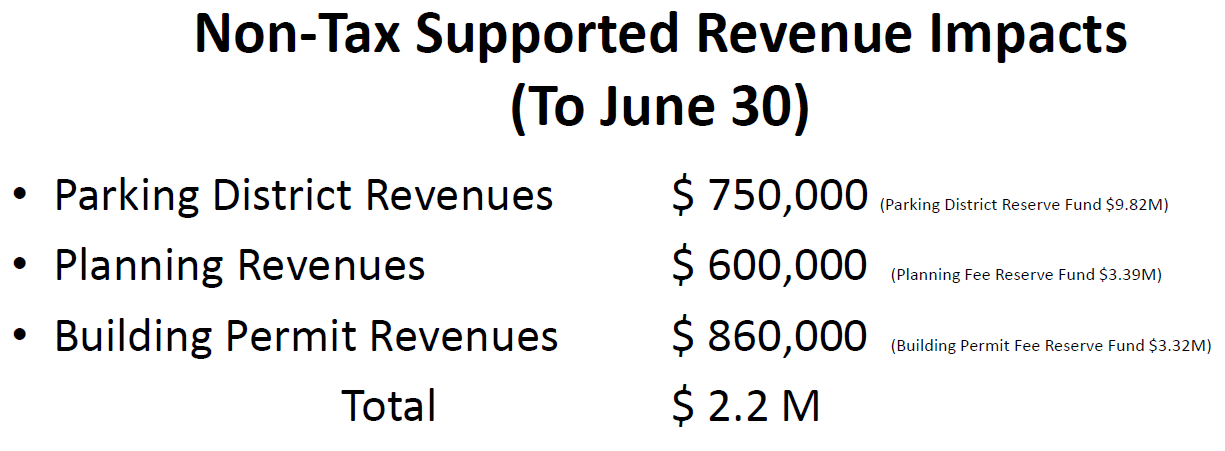 These are funds the city will also not get but for which there are reserves that can be drawn upon. 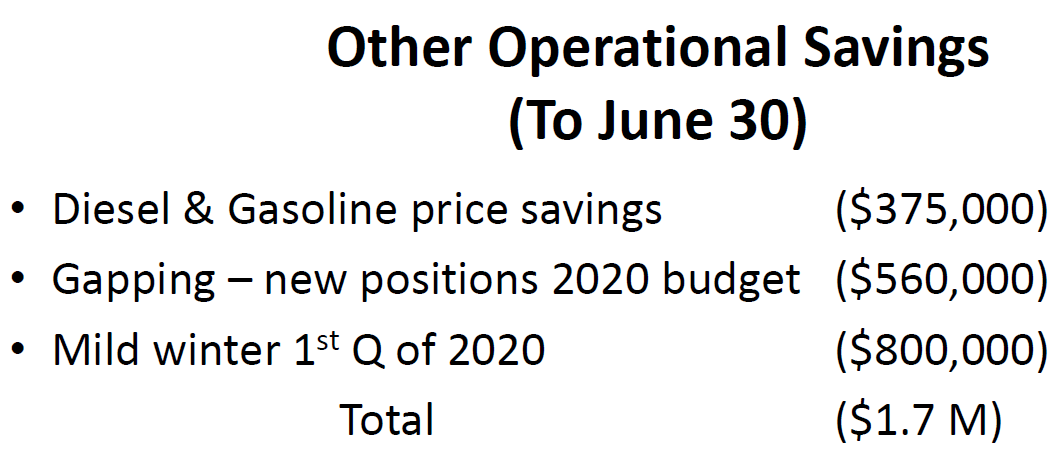 These are operational savings. Gapping is money budgeted for a job that is vacant. 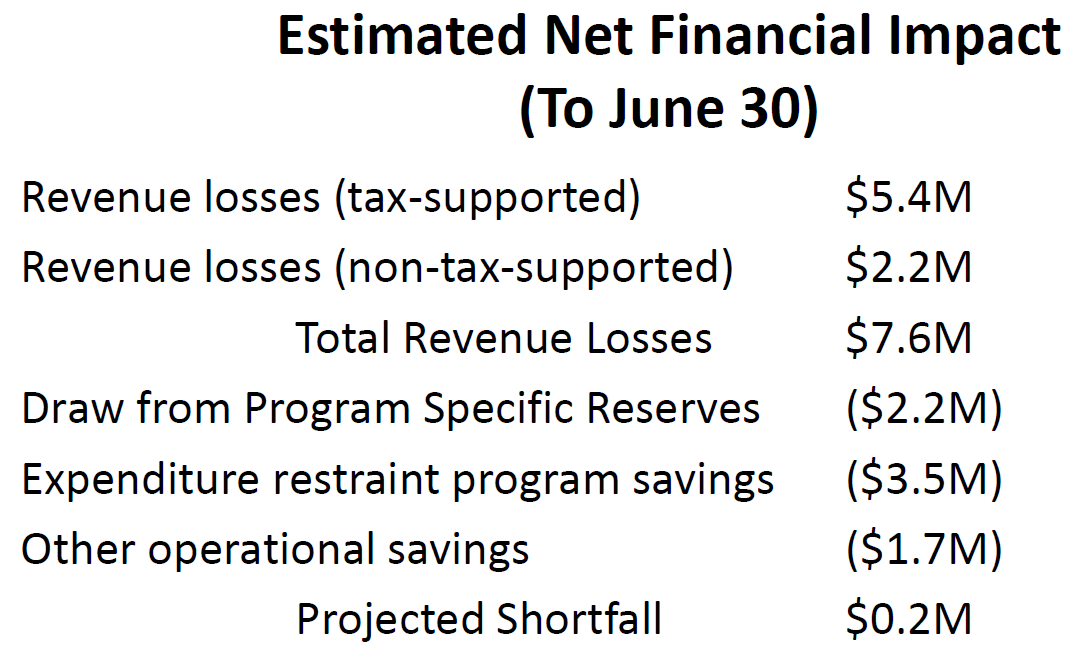 This suggests the city is short just $200,000
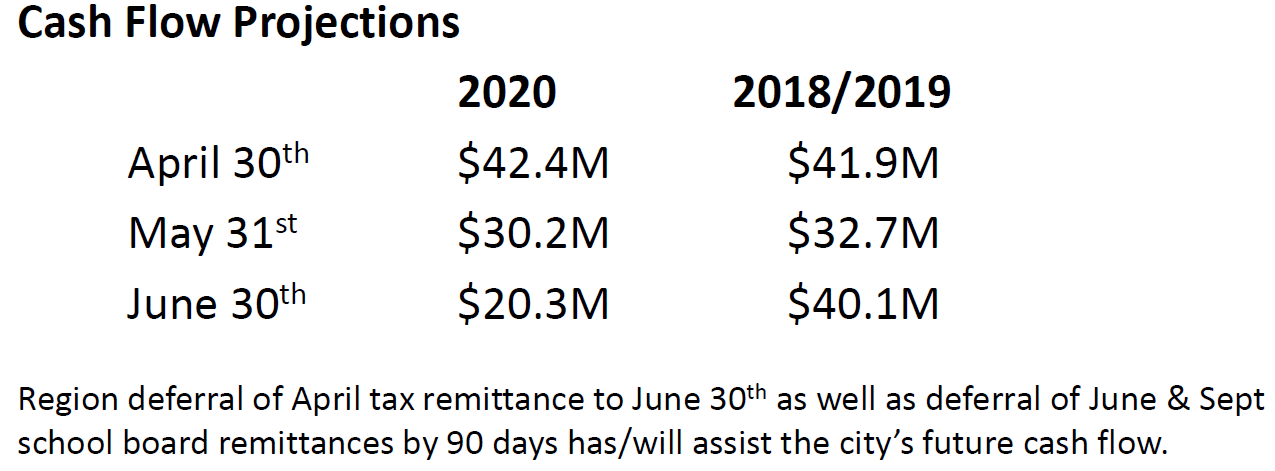 Projections are just that – projections. There are all kinds of things that can happen between now and July. Canada Day has been cancelled. Keep in mind – these numbers get us to end of June – early July.
Will the curve be flattened by then or will the virus make a return when people are permitted to congregate?
Municipalities are required to approve a budget that is balanced, however, the City can have a shortfall or surplus in a given year. A shortfall can be offset by:
• using reserve funds
• increasing taxes in the next year; or
• reducing expenditures during the year of the anticipated shortfall. This is what Burlington is attempting to do to mitigate a shortfall at year-end.
Three-month work plan for COVID-19 Emergency Response Strategy
The City of Burlington COVID-19 emergency response strategy defines the City’s resource needs over the next three-month operating period, to June 30, 2020, to deal with the effects and impacts of the virus on our community and staff. The COVID-19 emergency response strategy and the three-month work plan will be reviewed on a regular cycle to ensure relevancy for operations given the situation and circumstances of this dynamic environment.
Increased parking fines
Council also approved adding an increased penalty of $250 to specific parking infractions that violate COVID-19 bylaws and orders. Current parking penalties related to public health and safety issues such as blocking fire routes, accessible parking, idling and blocking snow operations range from $120 -$400. The add-on $250 penalty is in line with this range and is meant to act as a deterrent to parking in areas that are closed under the City’s COVID-19 State of Emergency. Enforcement officers have been given authority to decide when to apply the additional fee with the goal being education and compliance.
Virtual delegations
At the April 20 meeting, City Council also approved a recommendation to allow virtual delegations from members of the public at Council meetings, beginning in May 2020. For future council meetings, delegates can make a request to delegate to council using the online form or send an email to clerks@burlington.ca. Delegate speaking notes will need to be submitted to Clerks before the meeting in case there are connectivity issues. Delegates will speak to council virtually via phone or internet connection.
To prevent the spread of COVID-19, City Council meetings will continue to be held virtually. During this Council meeting, Mayor Meed Ward was the only member of Council present in Council Chambers along with the City Clerk/designate and an information technology technician. All members of Council participated in the meeting remotely and no members of the public were in attendance.

 By Ray Rivers By Ray Rivers
April 22, 2020
BURLINGTON, ON
 Peter Mackay – at full bore. Peter MacKay had a point – that the Conservatives needed to get a real leader to head their party. Though he may not have put it that way exactly. And he was adamant the Tory leadership convention should proceed, coronavirus or not.
That would have been foolhardy and the party wasn’t having any of it. You just don’t assemble a thousand or more party members for that kind of passionate event in the midst of a deadly epidemic.
But if MacKay didn’t get the memo neither did Andrew Scheer. For him parliament was just another day’s work – and everyone should be there daily – business as usual. Perhaps he could be excused for his devotion to the highest political temple in the country. Working for government was the only real job he’d ever had.
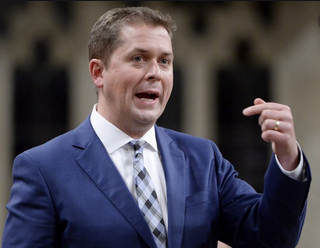 Andrew Scheer But hello, Mr. Scheer – there is a contagion raging throughout the land. Canada’s chief medical officer has told us that everyone’s health is important and MPs like everyone else need to exercise social distancing. As Britain’s PM, Boris Johnson, demonstrated, just because you’re an MP doesn’t mean you are immune from COVID-19.
But it’s pretty clear Scheer has trouble understanding what social distancing means. For example, when the government sent a nine person plane to pick up Scheer and two other MP’s, he insisted on bringing his whole family including all five of his children. Unmasked, they flew together sharing the same breathing space, and were packed-in like sardines in a can.
Unlike Scheer, the other three party leaders do get it. Green MP Elizabeth May believes they can hold the government to account without showing up in Ottawa. MPs from some provinces are required to quarantine after leaving their home province, making it difficult for them to attend. Bloc Quebecois Leader Yves-Francois Blanchet said the average person doesn’t care much about what MPs are up to in Ottawa [anyway].
So, stapled onto the first of a number of emergency funding bills was a request by the Liberals that they be given emergency authority to approve money bills without full parliamentary approval. That, they argued, would expedite the upcoming tranches of emergency funding bills to follow. Trudeau got royally hammered for trying that on.
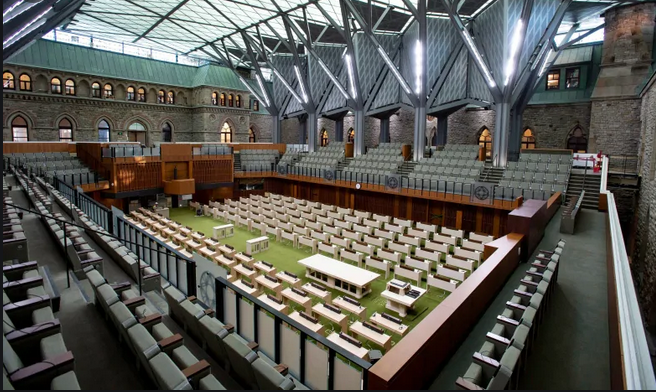 The House of Commons Chamber that the members work in while the Centre Block undergoes a ten year re-build.
To be fair the government probably was just trying to be expeditious and avoid having MPs co-mingle as a group greater than five persons. In a minority situation the opposition could always work together to defeat the Liberals should they feel it necessary. And besides, as we all expected, the funding bills went through pretty much unchanged – so the debate was essentially a rubber stamp. But that was a war measure and this is not war – or is it?
And the funding did take longer to get in place as a result of having to follow due process – something Scheer later complained about, ironically. Though, in fairness, he wasn’t the only one to hold up the emergency response.
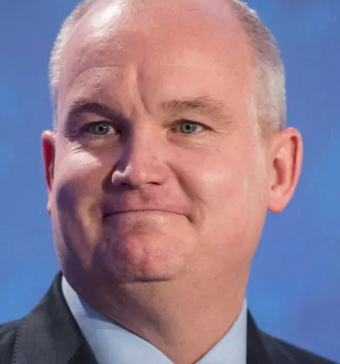 Erin O’Toole MacKay has been adamant that the Tories need a new leader. Of course he is currently the odds-on favourite, even though there is a rising tide for Erin O’Toole in western Canada. There are a lot of things wrong about Scheer but it was probably the mean spirited and miserable campaign last election that wrote his ticket.
Even though he had won the most seats in the House, everyone knew it was only because of western alienation. Some people prefer not to face the truth, even if it is in their best long term interest. Another pipeline or two are of no value if nobody is buying oil. And when the price of even West Texas oil falls so low that the oil companies are paying people to take the oil, it’s time to get out of Dodge…and your gas guzzling Dodge too. The future is clear.
Knowing Scheer had to go, the Tories must have been hopeful to pick amongst the wealth of potential candidates at their pleasure. But it didn’t turn out that way. Rona for personal reasons, Lisa because her neck wasn’t red enough. And Michael because he was just a nice guy – and we know where they finished.
And even Kevin was up to his ears after he and his wife got up to that nasty business with their yacht. Oh, if only Maxime was back in the game. Jason Kenny has his hands full at the moment. And Doug Ford… well….
So it’s Scheer for the interim and that’s a pity for all of us. He’s actually relented now and agreed to a new consensus plan, including virtual meetings. Still you’d think he’d get it. The only reason he’s still in that job is because COVID-19 postponed the Conservative leadership contest. But he still doesn’t take social distancing seriously. I wonder what Peter MacKay thinks about all that.
Leadership – it means walking the talk. That is another reason why the Tories need a new leader.
 Ray Rivers writes regularly on both federal and provincial politics, applying his more than 25 years as a federal bureaucrat to his thinking. Rivers was once a candidate for provincial office in Burlington. He was the founder of the Burlington citizen committee on sustainability at a time when climate warming was a hotly debated subject. Ray has a post graduate degree in economics that he earned at the University of Ottawa. Tweet @rayzrivers Ray Rivers writes regularly on both federal and provincial politics, applying his more than 25 years as a federal bureaucrat to his thinking. Rivers was once a candidate for provincial office in Burlington. He was the founder of the Burlington citizen committee on sustainability at a time when climate warming was a hotly debated subject. Ray has a post graduate degree in economics that he earned at the University of Ottawa. Tweet @rayzrivers
Background links:
Scheer on COVID 19 – COVID Emergency Bill – Scheer Flight –
Economic Response Plan – Who Held Up Government –

Weekend Indoors: How Burlington Residents Can Create a Stylish Night Out from the Comfort of Home and get caught up on some entertainment and political gossip.
 By Claire Nash By Claire Nash
April 21st, 2020
BURLINGTON, ON
Another weekend – during which you will be home-bound.
It doesn’t have to be a grim weekend.The weekend is almost here. It may not yet be time to get out for a walk in a park – but you can get creative and spend home time doing fun things.
Check out these three innovative ideas for creating a night out on the town right at home, so you get the best of all worlds over the weekend.
 Think creatively when you set up a bar. Turn Your Kitchen into a Cocktail Lounge
Hesitant to hit the bar? You can create your own state-of-the-art cocktail lounge right at home. Start by gathering up the essential home bar ingredients, making sure to grab any flavors and mixers you can’t live without. You don’t want to get stuck with a boring combination, so plan your purchases ahead of time to suit your tastes. Likewise, pick up some tried-and-true cocktail snacks to munch on like cornichons, mixed nuts, or candied fruit.
Once you’ve gathered all your necessities, break out your most lavish cocktail glasses to give your drinks some flair. This is important, as it means the difference between creating a cocktail lounge atmosphere and settling for a kitchen counter vibe. After that, simply don your fanciest garb and get to mixing. You’ll have to be your own bartender, but you’ll be able to rest easy knowing that your drinks will come exactly the way you like them.
Host a Casino Night on the Couch
Missing the casino? A night at your favorite venue can be a thrilling way to pass the time on the weekend. Of course, you don’t have to head outside to get your game on. Thanks to Canada’s friendly iGaming laws and a plethora of web-based venues, it’s easy and safe to create a casino night right at home. Online casino providers like Unibet offer the full gambit of games and sports betting options to choose from, so you’ll find something to fit your preferences no matter what you like to play.
Create a Movie Theater Cinema at Home
You can’t drive downtown to CineStarz Theater? But you can create a home cinema experience that’s worth staying in for. However, you should keep a few tips in mind to get the optimal experience.
In need of some cinema entertainment? There’s no reason to pay big bucks for the theater when you can have your movie night at home
 Make it personal – give your theatre a name. Set the scene by rearranging your furniture. You can organize everything to have a bit more space around the coffee table for snacks, or you can create classic movie rows for your audience. Either way, make sure the screen is viewable from every seat in the house.
It’s also a great idea to put out some classic cinema treats for your fellow moviegoers to enjoy. Popcorn is a tried-and-true munchie that gets everyone in the mood, but you can go all-out with nachos, extra-large iced sodas, or anything you like. Food is a major aspect of the movie theater experience, so pick your refreshments wisely.
Ready to have the perfect night out indoors? If you’re willing to put in a bit of effort, you’ll be able to create that perfect cocktail lounge, casino, or movie theater experience without leaving the living room. All you need is a bit of imagination, and you’ll be on the road to home-based bliss in no time flat.

 By Staff By Staff
April 20, 2020
BURLINGTON, ON
The Halton Public Health Unit releases data on a regular basis. This is the data up to end of day on April 19, 2020
Cases over time
37 COVID-19 cases reported to Halton Region Public Health since the last update (27 confirmed + 10 probable)
439 COVID-19 cases reported to Halton Region Public Health to date (383 confirmed + 56 probable)
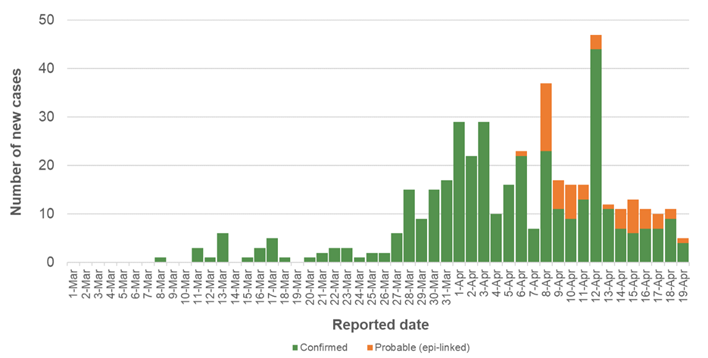
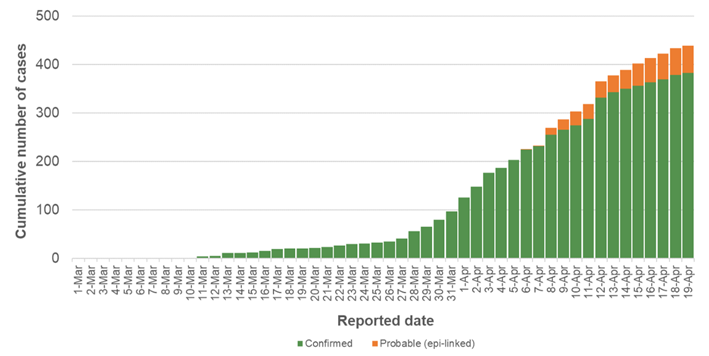
Figures above show the 439 COVID-19 cases that had been reported to Halton Region Public Health by end of the day on April 19. All cases have been graphed according to the date they were reported, which is often several days after the onset of symptoms. Top shows the number of new cases per day, while bottom shows the cumulative cases over time. Among the cases in these figures, 37 were reported since the last update (meaning they were reported between April 16 and April 19, 2020).
Individuals who are lab-confirmed cases are shown in green. Individuals who are probable cases are shown in orange. Probable cases are epi-linked cases, which means they are presumed to have COVID-19 because they are symptomatic close contacts of cases or returning travelers who have COVID-19 symptoms.
Case demographics
70 cases were residents or patients of an institution experiencing an outbreak (16% of all cases)
62 cases work in health care (14% of all cases)
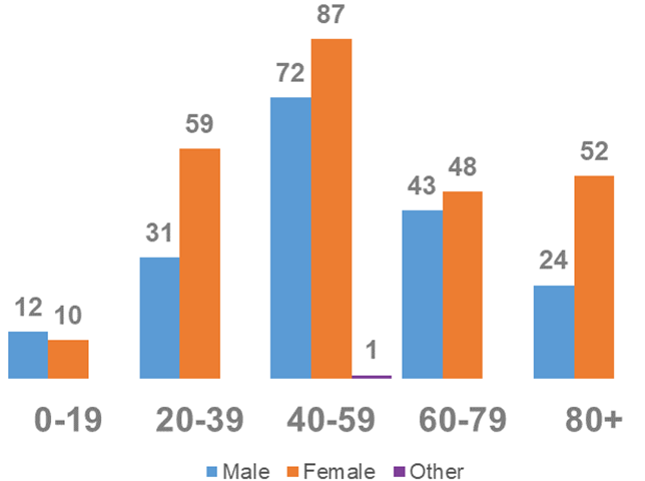 Figure shows that by end of the day on April 19, the most COVID-19 cases were among Halton residents aged 40-59 (with 160 cases, or 36%). 256 of the 439 cases (58%) were female. 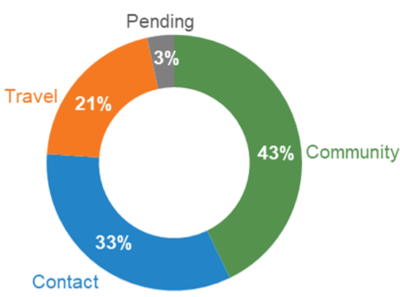
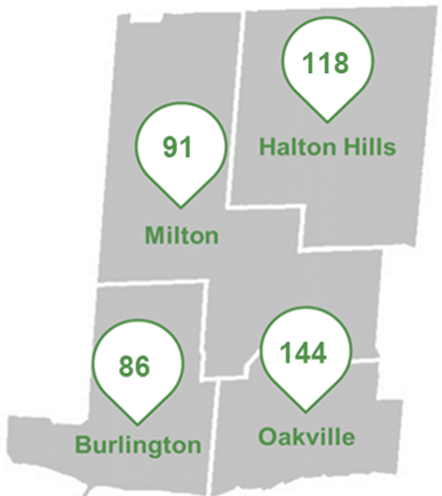 Covid cases by municipality Figure shows that by end of the day on April 19, the greatest number of COVID-19 cases were among residents of Oakville (with 144 cases, or 33%). Please note this figure shows counts, and therefore does not take into account the different population sizes or age structures of the four municipalities. Counts in municipalities can also be inflated by outbreaks that have occurred within institutions in their boundaries.
Case exposure source
Figure shows that by end of the day on April 19, 188 of Halton Region’s COVID-19 cases (43%) had no known travel or contact history, and therefore were believed to have acquired the virus within Ontario, making them community cases. 146 cases (33%) had contact with a confirmed case that was believed to be the source of their infection. 90 cases (21%) had a history of travel that was believed to have been the source of their infection. Information on exposure source was pending for the remaining 15 cases (3%).
Case outcomes
57 cases who have ever been hospitalized to date (29 listed as currently in hospital)
188 cases who have recovered to date
16 cases who have died to date (9 of the deceased were residents or patients of an institution experiencing an outbreak)
Institutional outbreaks
9 confirmed institutional outbreaks of COVID-19 are currently ongoing in Halton
10 confirmed institutional outbreaks of COVID-19 reported to Halton Region Public Health to date
Among the ten confirmed institutional outbreaks reported to date, five (50%) have been in retirement homes, three (30%) have been in long-term care homes, and one each have been in a hospital and a group home. Nine of the outbreaks remain ongoing. Please note these counts do not include any suspected outbreaks that remain under investigation.
Lab testing
>6,000 Halton residents are known to have been tested for COVID-19 to date
Comparison to Ontario
11,184 total confirmed COVID-19 cases reported in Ontario to date
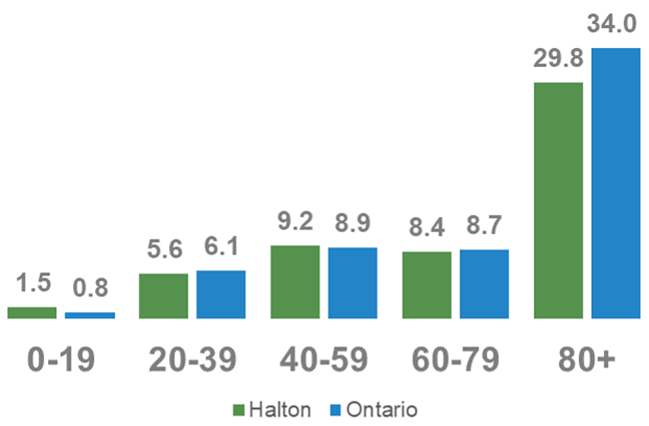 Figure shows age-specific rates of COVID-19 for Halton and Ontario. Rates take into account the population size of each age group to make it possible to compare between different areas. Halton’s age-specific rates are similar to the provincial rates for all age groups (for example, while Halton has 29.8 cases per 10,000 residents aged 80+, this is not statistically significantly different from the 34.0 cases per 10,000 residents aged 80+ in Ontario). It is important to note that these rates will fluctuate as numbers increase throughout the pandemic, and that differences between age groups may reflect differences in the likelihood of developing symptoms and being tested.
There are people who are concerned about the validity of some of the Regional data. One resident wrote the Public Health Unit and got the following response:
Confirmed cases are posted frequently to Halton.ca. Confirmed institutional outbreaks including facility names and date outbreaks declared can be found listed below the “Current Cases in Halton” section of our webpage. Having said that the confirmed cases there are a reflection of the residents/patients within each facility. It does not reflect the staff affected in those numbers at this time. Confirmed cases are reported by municipality of their residence. Of which, there is no reporting structure that reports this without breaching privacy and confidentially mandates in protecting an individuals identity. The reporting structure now used on the Halton.ca webpages reflects changes to reporting made at the Provincial level.
Rest assured, our case numbers in Halton Region are updated daily as we conduct a risk assessment for every COVID-19 case. Based on the risk assessment, high-risk exposures are followed up on according to Ministry and Public Health Ontario guidance. Any individuals deemed close contacts of COVID-19 positive cases will be notified directly. If an outbreak is declared at the long-term care home, there are specific measures must be taken. Positive clients and their close contacts are being case managed and monitored closely by Public Health.
Your concerns are valid and I would direct you to share your ideas at the Provincial level. The government of Ontario is welcoming ideas from businesses, organizations, and individuals to help address the spread and impact of the 2019 Novel Coronavirus (COVID-19) on our communities. Click this link to submit a proposal for ideas, other products or services to help Ontarians:https://www.ontario.ca/form/submit-your-ideas-to-help-fight-coronavirus
The demands on staff at the Public Health Unit are extreme. They are doing the best they can with what they have. A little more transparency on what is really happening at the long term care facilities would help people feel more assured.
Data limitations & data sources
Halton case data: integrated Public Health Information System (iPHIS), extracted at 7:00 AM on April 20, 2020, to reflect data entered by the end of the day on April 19, 2020
Halton lab data: COVID Data Information System, extracted on April 20, 2020.
Ontario case data: Public Health Ontario, Epidemiologic Summary, COVID-19 in Ontario: January 15, 2020 to April 19, 2020, posted on April 20, 2020 to https://www.ontario.ca/page/2019-novel-coronavirus
Denominators for Halton and Ontario age-specific rates: Population projections [2020], IntelliHEALTH Ontario, extracted on April 8, 2020.
Data notes
All cases of diseases of public health significance diagnosed in Ontario are entered into iPHIS by local public health units. iPHIS is the Integrated Public Health Information System. It is a dynamic disease reporting system which allows ongoing updates to data previously entered. As a result, data extracted from iPHIS represent a snapshot at the time of extraction and may differ from previous or subsequent reports as data are updated.
The data only represent cases reported to public health and recorded in iPHIS. As a result, all counts will be subject to varying degrees of underreporting due to a variety of factors, such as disease awareness and medical care seeking behaviours, which may depend on severity of illness, clinical practice, changes in laboratory testing, and reporting behaviours.
Cases are included if their “diagnosing health unit” in iPHIS is Halton Region, which means counts include only individuals whose primary residence is in Halton Region. The case may not necessarily have been managed by Halton Region, if they were temporarily residing elsewhere during their case management period. Cases managed by Halton Region who normally live elsewhere but who were managed by Halton Region staff because they were temporarily residing in Halton during their case management period have not been included.
Cases for which the Disposition Status in iPHIS was reported as ENTERED IN ERROR, DOES NOT MEET DEFINITION, DUPLICATE-DO NOT USE, or any variation on these values have been excluded.
Figure 1 distinguishes between lab-confirmed and probable cases. Since April 7, probable cases are defined as epi-linked cases, meaning they are symptomatic close contacts of cases or returning travelers who have COVID-19 symptoms and therefore are presumed to have COVID-19. All other figures and numbers include both confirmed and probable cases combined.
In subsequent reports, counts in Figure 1 may increase as cases are added from past dates due to delayed data entry or new arrival of lab results. To minimize such retrospective changes, cases have been graphed according to case reported date, which does not reflect onset of illness.
Cases are considered to live in an institution if the name of a facility (e.g. a long-term care home, retirement home, prison) has been entered for their address in iPHIS.
Cases are considered to work in health care if they are known to have an occupation that involves caring for patients, e.g. physician, nurse, occupational therapist, recreational therapist, chiropractor, paramedic, midwife, orderly, etc.
Exposure type is determined by examining the MISSING

 By Nicki St George By Nicki St George
April 21st, 2020
BURLINGTON, ON
Nicki St George is part of a Team that details how their weeks goes as parents do their best to cope with the Corono virus and take on the task of educating their kids. Nicki has two children; a nine year old boy and a six year old girl. Husband Dan is working from the house – office in the basement. Nicki has completed her chemo therapy and is happy with her cancer recovery.
 Daughter – a work in progress. WEEK 5
MONDAY, April 13
Bea storms out over a disagreement about Candy Land. She says she is going to find a new home. I suggest that she pack a bag. Leo watches from the window. It’s so windy that her umbrella blows inside out. We laugh until she comes back inside and then feign concern. She is a character. She comes back inside to tell me that from now on she is going to live in the car except for meals. She will take her iPhone, but she promises not to use it until the scheduled time (3:30pm). I point out that the Wi-Fi is crap in the driveway, so she relents and has her iPhone time inside the house. Tomorrow, when Dan takes the car to the grocery store, she will ask why dad is driving away with her new home.
TUESDAY, April 14
This week I have resolved to go for peaceful walks by myself every morning when I wake up for sanity’s sake. This will last two days. I miss going for walks with my friends; it’s boring all by myself. In the afternoon, the kids insist on going for a bike ride, which I’m opposed to because it is so cold. On our ride I pass some friends of my parents and stop to say hi. Leo warns me against talking too long, in case we get a ticket like that lady whose friends drove by her house to wish her a happy birthday.
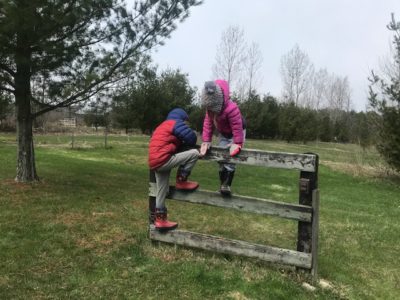 Out at the grandparents farm where there is acres of space to run and roam WEDNESDAY, April 15
On our weekly pilgrimage to my parents’ property we listen to a podcast about Weird Al Yankovic’s appeal (I’m actually quite curious about this). My parents are having some trees cut down from their property, so we stand in the brisk, April wind and watch the men take down a tree. This is the most exciting thing that will happen to us all week. The kids nearly miss it because they are wrestling on the ground.
Every mum I talk to is tearing their hair out today. I empathize. I often wonder if Bea has been sent to test me. Our conversations go something like this:
Bea – so is the answer 3
Me – no, it’s 4
Bea – That’s what I said! Whines and storms out of the room.
THURSDAY, April 16
Dan and I finish watching Unorthodox on Netflix. I am envious of how long that girl’s hair is. (In case you haven’t seen it, it is a very short pixie cut.) Every day and I check the progress of my hair regrowth. I examine my pathetic eyelashes and eyebrow hairs which I can count individually. Then I draw on a new pair. I am tired of looking like a sick person. Bea sees me doing this and now she does her eyebrows every day too. I do really love that kid. I have my appointment at the hospital today and when I get home, I cannot be bothered to do any schoolwork with the kids. We spend the day doing a puzzle and playing Mario Kart.
 Nine now. FRIDAY, April 17
We listen to the Kidsnuz podcast and today they announce Leo’s birthday (all the way from Burlington, Ontario!). His excitement at hearing his name through my iPhone brightens my day. At 6pm, Dan emerges from his work cocoon and makes delicious homemade pizza. I prepare a foot bath and give Bea a full nail salon experience including a face mask. She is in heaven.
SATURDAY, April 18
Today is Leo’s 9th birthday. Instead of the new bike and new bed that he had been promised, we get him a couple of games for his Nintendo Switch and a few t-shirts with witty captions. He spends the day playing Roblox while on messenger with his friends. At around 1pm, a few of his friends (and their parents who are our friends) stop by and we all try to catch up while keeping our distance on our front lawn.
Leo approaches me and tells me that the closeness is making him uncomfortable and he is worried that we will get fined. Seriously where did this child come from? I sometimes forget that Leo has inherited Dan’s sensibility, but I’m grateful for it in this moment, because he is right. I politely ask everyone to get back in their cars and we slowly disperse the crowd. I think we were all so starved for some socialization and Leo’s birthday provided the perfect window to have some face to face contact.
After everyone leaves, Leo opens the gifts they brought – cupcakes, seafood, homemade cards and pictures, and some gift cards. We are all touched by the effort everyone has gone to, considering the circumstances. Later we make his meal of choice and a chocolate pavlova for dessert which we serve up over Houseparty with my extended family. Leo hasn’t complained once about his COVID19 birthday and I feel very proud of him.
SUNDAY, April 19
 The cat just seems to go with the flow. I pet the cat, do some of my puzzle, read something, knit, repeat. This is how I spend the day. I am feeling bored and restless. I want this period of social distancing to be over. I would settle for just knowing when it will be over. My newsfeed is depressing -a mass shooting in NS and idiots protesting social distancing measures in Michigan.
Bea’s behaviour has become intolerable and I refuse to live under her regime any longer. Everything is a battle with her, including the basics such as getting her to wash her hands. Dan and I decide to enact Marshall law which involves no treats, no smiles and no iPhone until there are three consecutive days of good behaviour. She is receptive so far and we have a pretty good day with Dan enlisting her help doing yard work. I guess fixing Bea will be my project for the upcoming week. She’s still a work in progress, but I guess we all are…

 By Pepper Parr By Pepper Parr
April 20, 2020
BURLINGTON, ON
The City has put out an update on what it expects of its citizens.
The parks are closed and are going to remain closed.
City staff are focused on delivering essential services.
With the arrival of warmer weather, residents will start to see City of Burlington staff begin spring maintenance work in City parks and roads:
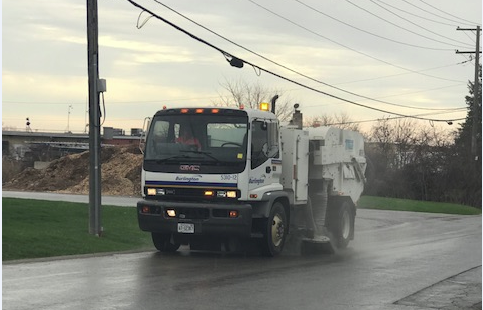 Expect to see equipment like this on the streets • Street sweeping has begun on arterial roads and crosswalks with residential roads scheduled to begin mid-May
• Park and roadside litter clean up where needed prior to grass cutting
• Grass cutting will begin but will not include the usual trimming around trees and other objects
• Repair work for grass that has been damaged by sidewalk snow plows will begin the week of April 27with a contractor visiting the sites to fill areas with soil and grass seed
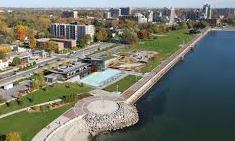 City wants to keep pedestrian traffic to a minimum. Staff are only doing essential work to maintain City parks, facilities and assets until further notice. Wood chips at the Operations Centre on Harvester Road are not available for pick up during the pandemic and community gardens will remain closed as they have been deemed non-essential by the Provincial government. The City has delayed Community Garden openings until further notice.
To help keep everyone safe during the provincial emergency order, Spencer Smith Park is only available for walk-in traffic. The parking lots are closed and only walking is permitted in Spencer Smith Park, including the Promenade and the Brant Street Pier.
Visitors must keep a two-metre distance from other walkers. No other activities are permitted until further notice: no running, no rollerblading and no biking through Spencer Smith Park. This is to reduce the volume of people in Spencer Smith Park and to help walkers maintain physical distancing.
Physical distancing during the COVID-19 pandemic is one of the most important steps everyone needs to take. The COVID-19 virus doesn’t move on its own; it needs people to move it.
Remember to:
• Keep two metres away from others – about the length of a hockey stick
• Move to the right on pathways to make room for others to pass safely
• Carry out your garbage whenever possible
Respect the caution tape and keep off playgrounds, sports fields, skateboard areas, tennis and basketball courts. The City has signage and barricades in the entrances of parking lots to block vehicles from parking. Vehicles left in parking lots will be towed at the owner’s expense.
Residents who see groups of five or more people gathering or individuals using outdoor recreational facilities can call the Halton Regional Police Service COVID hotline to file a report at 905-825-4722.
Local enforceable orders include:
• Closure of places of non-essential businesses
• Prohibiting events and gatherings of more than five people
• Closure of public places and establishments
• Closure of all outdoor recreational amenities and parks
Burlington Transit
As an essential service, Burlington Transit continues to operate on a modified schedule for essential trips only. Essential trips include going to medical appointments and picking up medication or groceries. Extra buses will be added if needed to help protect drivers and allow passengers to practice physical distancing from other riders. Please use the back doors to enter and exit the bus, keep behind the marked area and follow the recommendations of public health professionals. For more information on Burlington Transit, visit www.burlingtontransit.ca
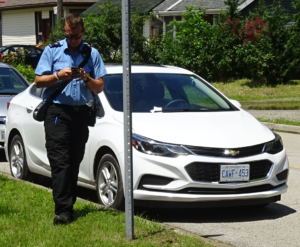 Not much work for the parking control people. Parking
Parking enforcement is currently limited to safety-related issues such as fire routes, accessible parking, no parking/stopping areas and blocked areas, including parking lots at Spencer Smith Park, Lowville Park and all other City parks. Time limit restrictions have been relaxed to help those working from home or self-isolating. Parking permits and exemptions are not required until further notice. For more information on parking, visit www.burlington.ca/parking.
Service Burlington
Customer Service staff are available by phone and email for residents’ questions. Online forms can also be submitted via our website. Only in-person services, such as marriage licences, are not available during the pandemic.
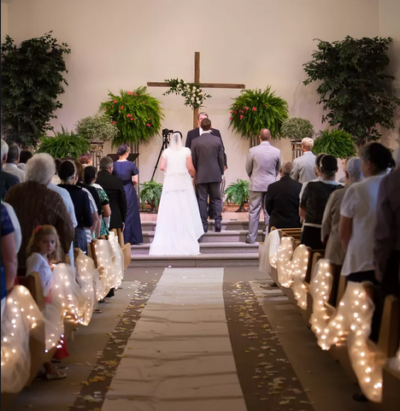 Not going to tie that know this month – maybe not in June either. The City of Burlington is not issuing marriage licences while City Hall is closed. Residents needing a marriage licence can call Service Burlington two weeks before their intended marriage date and if City Hall has re-opened, will be accommodated as close to their wedding date as possible.
Municipalities issue marriage licenses on behalf of the Province of Ontario. Current legislation requires original signatures and documentation. City staff have asked the Province to review this legislation and make some interim amendments to allow for electronic signatures and documentation. Staff is also asking the Province to extend the licenses that were issued prior to the COVID-19 shutdown beyond the normal 90-day expiry dates.
In-Home Activities
The best thing residents can do to protect themselves and the community, is stay home. The City of Burlington and its partners have put together a list of activities people of any age can do while staying home at burlington.ca/programming. The list includes:
• Virtual fitness
• Free music
• Ebooks, emagazines and online resources from Burlington Public Library at bpl.on.ca
• Videos for recreation programming such as games, activities and crafts.
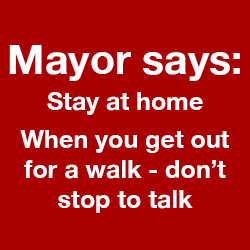 Mayor Marianne Meed Ward cautions people. “As the weather gets warmer we know it will be harder to follow the provincial emergency orders, and the directives from Burlington City Hall. But we must continue to stay apart, and stay in our own neighbourhoods, so we can get through this sooner. Please resist the urge to congregate in groups, stay 6 ft. away from anyone you don’t live with and please stay in your own neighbourhood and local parks for your walks. Mayor Marianne Meed Ward cautions people. “As the weather gets warmer we know it will be harder to follow the provincial emergency orders, and the directives from Burlington City Hall. But we must continue to stay apart, and stay in our own neighbourhoods, so we can get through this sooner. Please resist the urge to congregate in groups, stay 6 ft. away from anyone you don’t live with and please stay in your own neighbourhood and local parks for your walks.
“Walk, don’t stop, and stay off playgrounds, benches and other park amenities. In particular, please do not come downtown to the waterfront where there has been some crowding in Spencer Smith Park and Beachway Park. We have taken extra measures to restrict the use of these areas.
“We know how difficult this has been so far for our residents, but it will only get more difficult the longer we have to keep these directives in effect. The longer we stay apart now, the sooner we can safely come together.”

 By Staff By Staff
April 20, 2020
BURLINGTON, ON
The Paletta family announced a donation of $500,000 to support pandemic relief efforts that is to be split equally between Hamilton and Burlington.
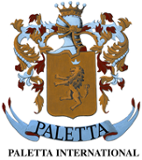 This major donation is intended to address the needs of vulnerable people and families including those experiencing homelessness and poverty, isolated seniors, people with disabilities and other marginalized communities. This major donation is intended to address the needs of vulnerable people and families including those experiencing homelessness and poverty, isolated seniors, people with disabilities and other marginalized communities.
It is the largest donation yet to the fund and will also support agencies to adapt their services or operations as needed, as a result of COVID-19.
“Though each of us is affected by the current crisis, the impact is far greater on some citizens than on others. We wanted to make a difference for those who are already in difficult circumstances,” says family spokesperson Paul Paletta. “We feel blessed to be able to help in this unprecedented situation.”
“This donation is just one of many examples in the Paletta’s long history of philanthropy and community leadership, of stepping up whenever and wherever they can and inspiring others to do the same. Their remarkable gift will help reduce uncertainty for our city’s most vulnerable at this critical time and in the months ahead.”
 In Burlington, the Paletta family’s donation will support Burlington Foundation’s Covid-19 Response Fund which prioritizes food security, medical assistance, mental health and safe housing. In Burlington, the Paletta family’s donation will support Burlington Foundation’s Covid-19 Response Fund which prioritizes food security, medical assistance, mental health and safe housing.
“In this overwhelming time, remarkable generosity like the Paletta’s offers hope and inspiration,” says Colleen Mulholland, President and CEO of Burlington Foundation. “As the number of vulnerable community members needing help grows, their gift will have meaningful impact.
“It’s a challenging time for everyone but it’s also heartening to see people contributing in their unique ways,” says Paul Paletta. “We encourage everyone to step up in whatever way they can because we can only get through this pandemic together.”

 By Pepper Parr By Pepper Parr
April 20th, 2020
BURLINGTON, ON
Everyone knows who the St. John Ambulance organization is – they are the people who give the First Aid course – or is that the Red Cross?
During this time of physical distancing, their Therapy Dogs of course cannot provide their usual canine comfort and care by visiting in person. However, they can still help break the sense of isolation and show the people we service how much we care, through ‘virtual visits’.
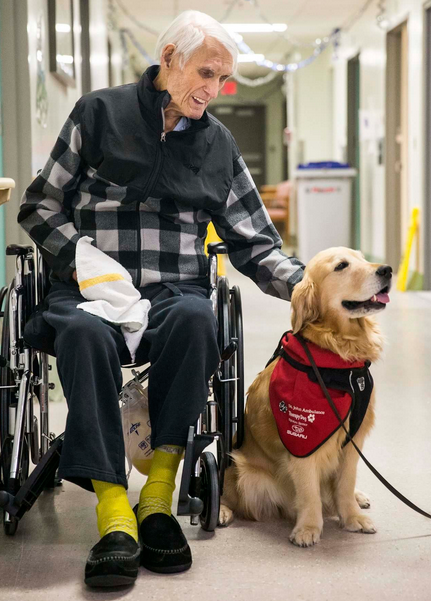 Therapy dogs make the days of people who are in a long term care home when they visit. In mid-March, they set up a St. John Ambulance Digital Therapy Dogs YouTube channel and invited our volunteers to submit video ‘letters’ about their dog. This was a chance to show the activities the dogs like to do when not being a Therapy Dog, as well as express how much we miss the people we’d normally visit.
The response had been tremendous, with over a hundred videos already uploaded, with more to come. We sent the word out to facility recreation program staff, and they’ve been loving the videos very much! They play them on a large screen in some cases, or help residents watch them on a tablet or computer.
Some of our teams have also sent regular newsletters that are printed and shared, while others send their video directly to the home they visit, in addition to uploading it on the YouTube channel. The diversity of the ‘virtual visits’ is part of the magic – you can take a sunny walk with Buddy and Charlie at the beach, watch Harvey unroll his yoga mat, see Bailey play with Piper, laugh while Ken battles Victoria for the ball, and be smitten by Finn as he shares his talent for fashion.
Discover your favourite Therapy Dog by visiting the YouTube Channel CLICK HERE
With almost 2000 therapy dog teams in Ontario, serving over 3100 facilities across the Province the Therapy Dog Program reaches out to thousands of people on a daily basis, bringing comfort, joy and companionship to those who are sick, lonely and residing in full-time care facilities. Clients reap the therapeutic benefits of the unconditional love of these four-legged friends.
 Kids who need some distraction cab be taken away from their problems by playing with a therapy dog. “St. John Ambulance Therapy Dogs offer assistance in programs for youth at risk, and help build self-esteem for those in correctional facilities. They can provide relief and a welcomed distraction to those waiting for radiation or chemotherapy treatment, and very sick children being treated in hospitals, as well as to people who are displaced and frightened during an emergency evacuation.
“And there is no doubt that people find it easier to express their deepest emotions and put into words their hopes and fears while hugging a dog, so we find our teams working with the Military, Police and Fire Departments, social workers, psychologist and psychiatrists to help victims of critical incident stress, crime, tragedy and abuse, overcome their challenges.”
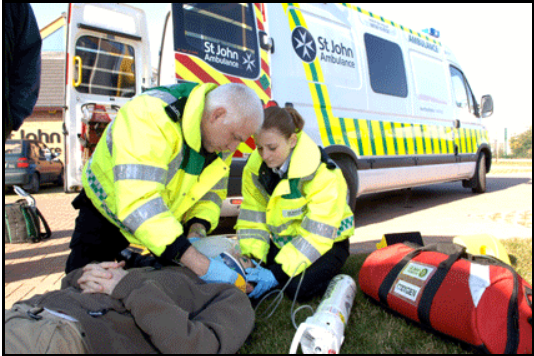 At almost every major public event – there is a St. John Ambulance on standby. St. John Ambulance offers a free on-line First Aid Awareness course to all Ontarians. In times of social distancing, accidents and injuries can still happen in the home or at the cottage. Right now, St. John Ambulance offers a free on-line course entitled: First Aid Awareness.
Their aim is to keep First Aid knowledge fresh in the minds of those who cannot take part in classroom training. Knowing what to do in an emergency can save someone’s life, and often, that life is someone you know and love.

 By Staff By Staff
April 20th, 2020
BURLINGTON, ON
The Longo supermarket people are said to be surveying their customers to determine if they are comfortable with store staff wearing masks and if customers would please in future wear a mask while in the supermarket.
The use of masks seems to be mixed – many people do wear them. Some are very elaborate while others are the “made at home” version which is just fine.
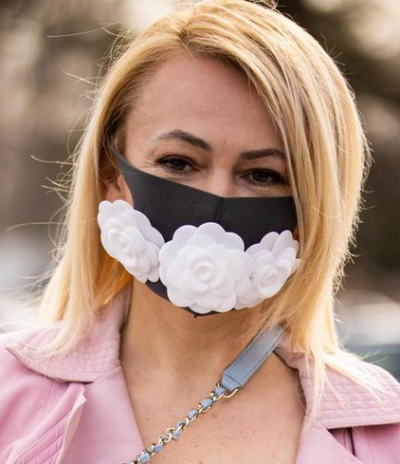 They are becoming fashion statements. Any day now we can expect facial masks to become fashion statements.
Are masks necessary? There are arguments on both sides of wearing them on the street and in the office.
Better to be safe than sorry is one argument we hear – the other is that they are only needed in medical situations or where you are working closely with people.
 In Hong King face masks have become political statements. It wasn’t long ago when we saw tens of thousands of people on the streets of Hong King demonstrating. Many wore the masks to keep the tear gas out of their eyes – while others wore them in social setting as a political statement.
Mask are clearly a symbol of these times – and there must be a demand for them. Difficult to find any in the stores – hundreds of women in the city are making masks and handing them out.
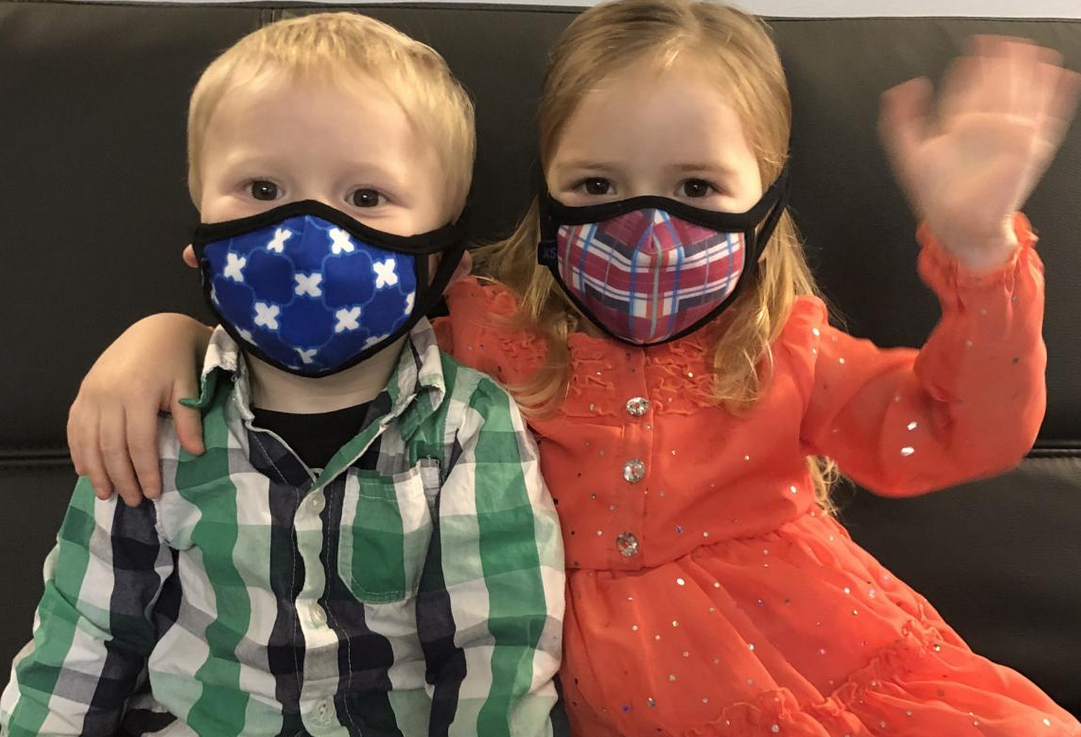 Expect to see pictures like this on Christmas cards this year. 
 By Pepper Parr By Pepper Parr
April 20th, 2020
BURLINGTON, ON
There is a group in one of the downtown condos on Lakeshore Road who gather up the wine bottles and beer cans in the condo recycle room and regularly drop them off at the Beer Store. The money they get is a fund raiser for various Social Committee functions and events.
With the Beer Stores no longer taking in empties regularly the cans and bottles were beginning to become quite a pile.
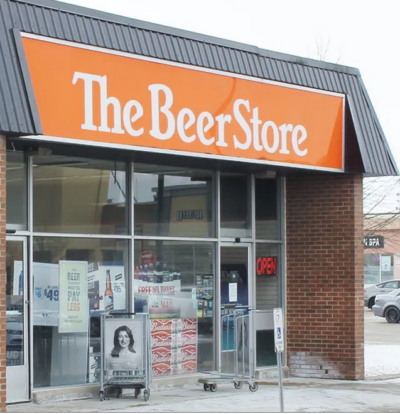 A resident tells us that it was his wife’s turn to take the bottles and cans in; having checked on line she learned that the only Beer Store accepting returns was the one at Upper Middle Road and Appleby Line. A resident tells us that it was his wife’s turn to take the bottles and cans in; having checked on line she learned that the only Beer Store accepting returns was the one at Upper Middle Road and Appleby Line.
After dropping off two SUVs worth of returns (This isn’t that big a condo – impressive number of cans and bottles, but I digress.), the wife came home with an interesting story.
The Beer Store had two staff disinfecting carts outside and staff inside spraying the bins.
There were two areas to line up outside – one for those purchasing and one for those returning.
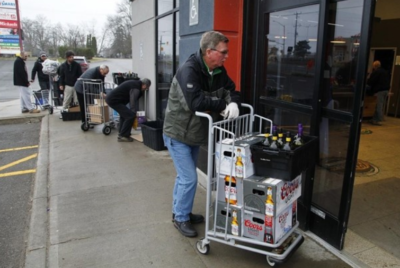 As well, there was an ability to simply drop off returns as a donation to the Joseph Brant Hospital. This helped to cut down on social distancing and the line up! Brilliant! As well, there was an ability to simply drop off returns as a donation to the Joseph Brant Hospital. This helped to cut down on social distancing and the line up! Brilliant!
“Kudos to the staff at this store on Sunday April 19th at 3 pm as they were friendly, efficient and helpful – my wife managed to break two bottles in the parking lot which they quickly came out to cleaned up.
“What started out as a daunting task – there was a four week supply to return – and usually a “ho hum” journey turned out to be actually enjoyable.
“Recycling (i.e. climate change) + Potential charity + friendly Public Service seems to me to be a win-win-win”, reports a condo resident.

 By Pepper Parr By Pepper Parr
April 19th, 2020
BURLINGTON, ON
City Manager Tim Commisso’s life has been boiled down to a single word – Risk!
 City manager Tim Commisso Everything he looks at is seen through a single lens; it is as if he is wearing a monocle.
Every decision is – what is the risk of doing something or the risk of not doing something.
His one job is to ensure the city provides the services needed to keep people safe and that staff provide the services needed to keep the city operating. It is a challenge.
Few have much in the way of an idea as to just how complex this is.
Commisso runs the show. His word is the final word. He listens and takes advice but at some point he has to make a decision and be held responsible.
He doesn’t always get it right. He had to learn to open up and ensure that members of Council were kept in the loop – aware of what was being done and why.
He is now giving Councillors a report each week.
He has the best people on the city payroll available to him at that virtual table – they communicate as a group twice a day – all by telephone.
The Mayor is reported to be the backup and takes turns chairing the Emergency Coordinating Group (ECG)
The two charts below show the ECG organizational chart that was created March 17th. The detail quality is poor – we have asked the city for a graphic with a higher resolution.
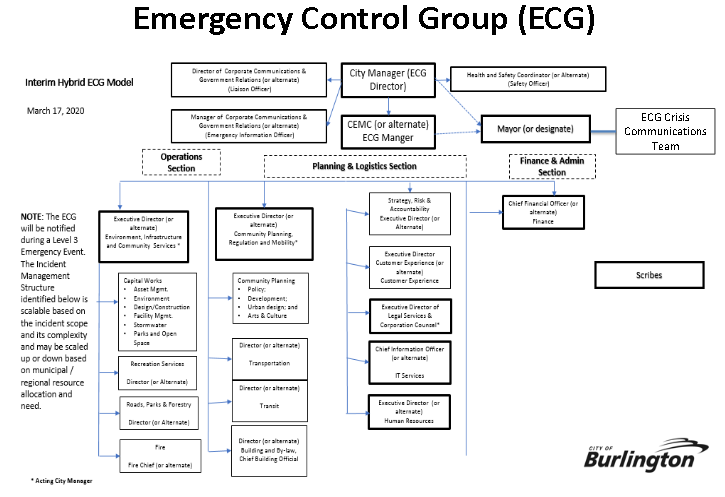
Commisso has set out the timeline he plans to follow in reporting to Council.
CSSRA is the acronym for the Corporate Services, Strategy, Risk and Accountability Standing Committee that is chaired by Rory Nisan with Paul Sharman as the vice chair.


 By Staff By Staff
April 20th, 2020
BURLINGTON, ON
This is not what we wanted to hear at the start of a new week.
“Humanity will have to live with the threat of coronavirus “for the foreseeable future” and adapt accordingly because there is no guarantee that a vaccine can be successfully developed, one of the world’s leading experts on the disease has warned.”
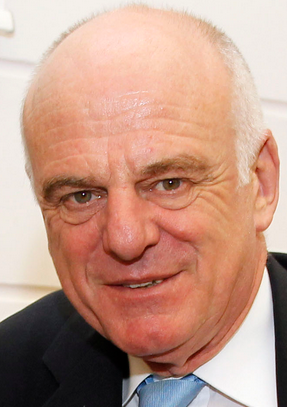 David Nabarro In an interview with The Observer, David Nabarro, professor of global health at Imperial College, London, and an envoy for the World Health Organization, said the public should not assume that a vaccine would definitely be developed soon – and would have to adapt to the ongoing threat.
“You don’t necessarily develop a vaccine that is safe and effective against every virus. Some viruses are very, very difficult when it comes to vaccine development – so for the foreseeable future, we are going to have to find ways to go about our lives with this virus as a constant threat.
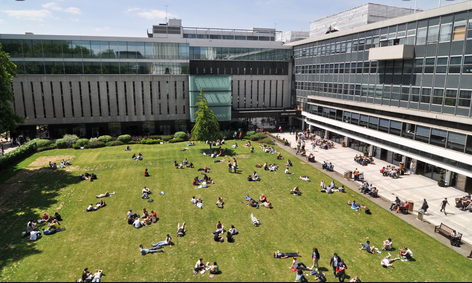 Imperial College, London “That means isolating those who show signs of the disease and also their contacts. Older people will have to be protected. In addition hospital capacity for dealing with cases will have to be ensured. That is going to be the new normal for us all.”
When it comes to credibility the Observer, a British newspaper, is as good as it gets and the Imperial College, London has a sterling reputation in these matters

 By Staff By Staff
April 18th, 2020
BURLINGTON, ON
On a Saturday afternoon when the news world is usually quiet the Region of Halton advised that the Mountainview Retirement Residence had:
63 residents and 18 staff confirmed as COVID-19 cases, with some lab results still pending.
8 deaths
The Public Health unit became aware of problems at Mountainview on March 31st – 16 days ago.
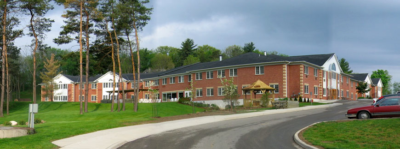 The Mountainview Retirement residence in Georgetown – 8 Covid19 related deaths. 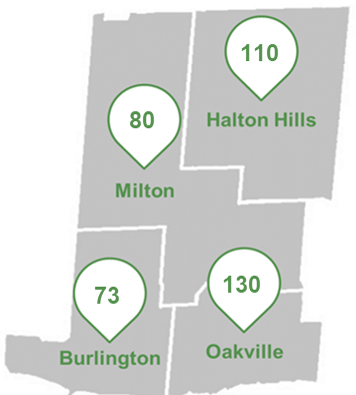 Data made public on the 15th did not indicate what was behind the Halton Hills number. 
 By Pepper Parr By Pepper Parr
April 18th, 2020
BURLINGTON, ON
The height of a building, the architecture and design are both important and for the people of Burlington they are, at this point, a major focus.
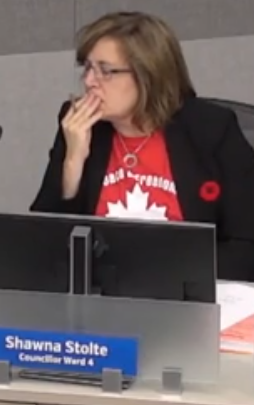 But more important than the two is the street. But more important than the two is the street.
Streets are where we live – yes, your home is on a street but a lousy street ruins the most impressive home.
Ward 4 Councillor Shawna Stolte will be putting a motion before Council on Monday – she wants to change the way streets are used during this COVID-19.
Stolte wants to direct the Director of Transportation Services to assess, create and implement as soon as possible, and with input from other city departments and members of the Cycling and ITAC Committees, a “Shared Streets Burlington” Pilot Project with the goal of temporarily closing portions of roadways to allow for safer physical distancing for pedestrians and cyclists for the duration of the COVID-19 pandemic.
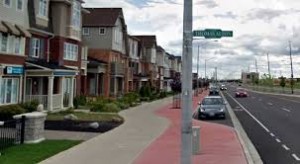 Under normal conditions – this is more then enough sidewalk – but these are not normal times The residents of Burlington, along with City Council and City Staff, are all committed to the goal of stopping the spread of COVID-19 in our community.
Stolte accepts that the role of City Council and staff, is to amplify the message of medical experts in regard to adhering to physical distancing requirements while also considering a longer term plan that acknowledges residents need for physical exercise and fresh air in order to effectively manage their mental health and well-being.
She points to recent Angus Reid Poll that asked, “if there is anything residents are doing more of than normal since being isolated” and 53% reported “going for more walks” and 26% reported “taking up extra exercise”.
City streets and sidewalks are places residents are permitted to travel outside their homes but sidewalks are simply not wide enough to ensure the physical distancing requirements recommended by medical experts and the informal use of grass boulevards does not provide a safe nor viable alternative for wheelchairs, strollers or bicycles.
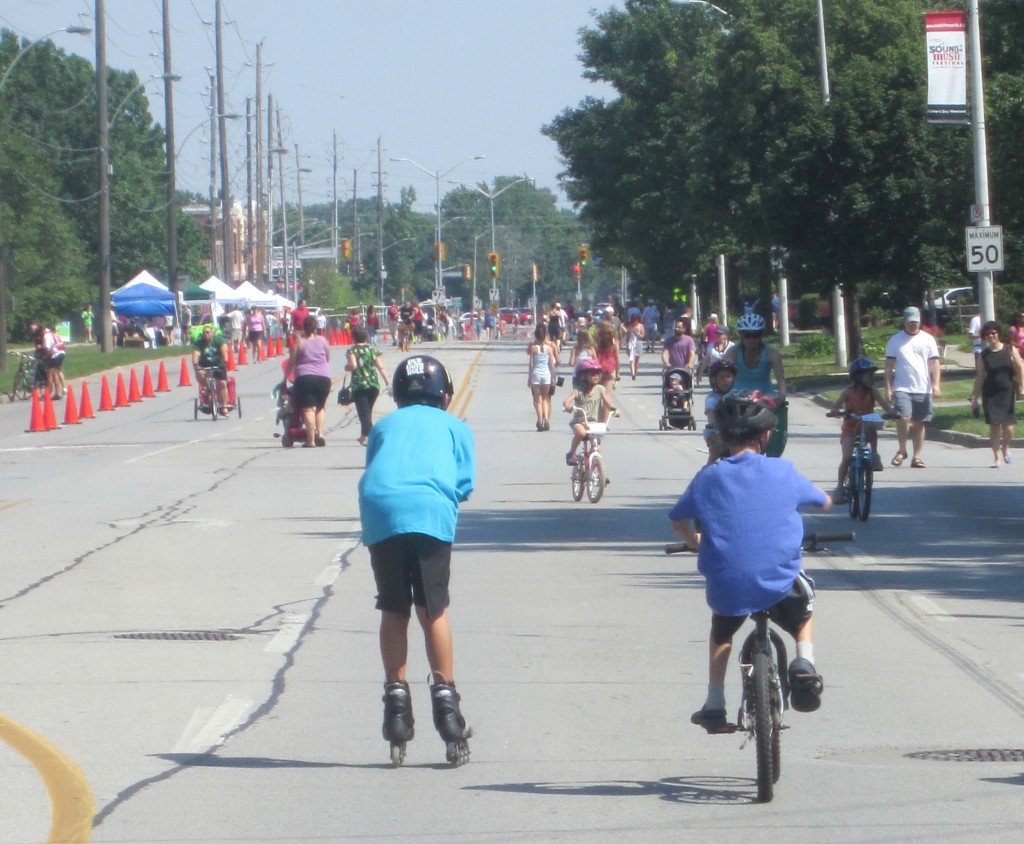 Is shutting down a street and opening it up to people who can just walk and ride bikes a solution? These sidewalks and multi-use paths are becoming more congested as the seasons change, temperatures are rising, and residents seek outlets to support their mental health and well-being.
The space to expand outdoor physical distancing is available.
Roadways are underutilized due to reduced traffic volumes and represent a clear and simple alternative to “expand the sidewalk”.
There are many resources already available, as well as an established work group comprised of dedicated residents from the ITAC and Cycling Committee who have been meeting to research strategies and suggestions for implementation.
Some suggestions are as follows:
- begin with a Pilot Project to measure, monitor and learn as well as to assess the willingness of the community to participate in a safe manner;
- consider a phased approach that can adapt/expand as needed;
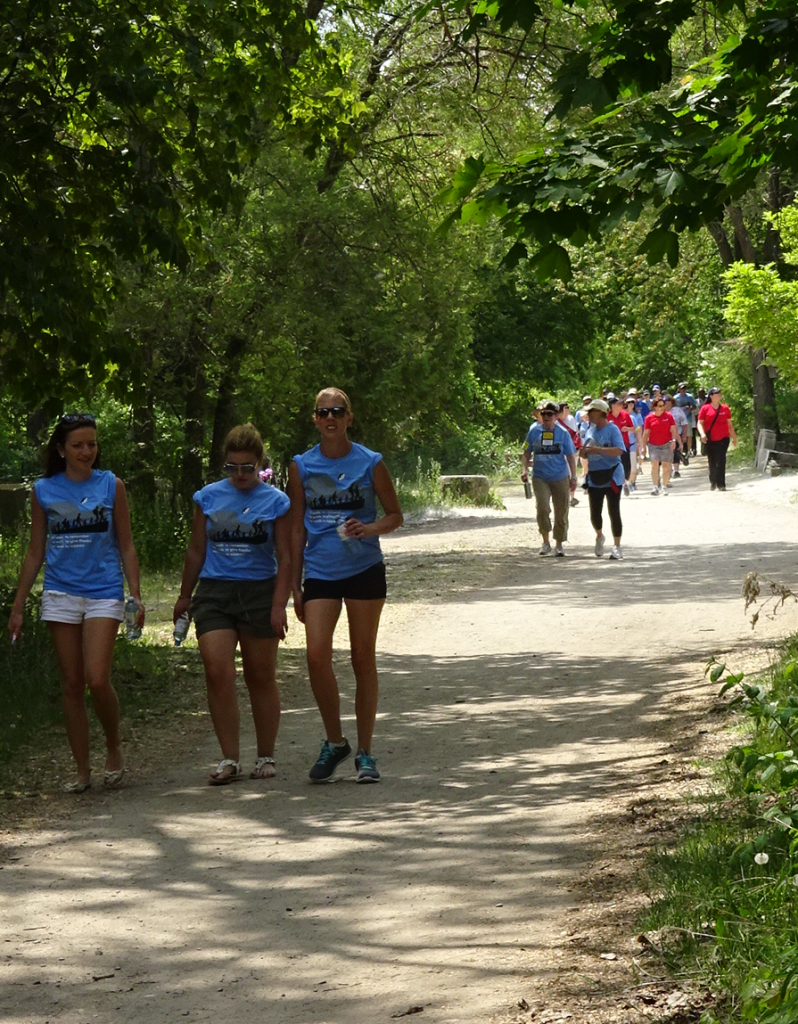 Community walks like this are not on – the Beachway Trail can’t handle the traffic – can part of the roadway be opened to pedestrians?
- offer multiple, local, widespread, “very ordinary” locations to create the opposite of a destination to avoid gathering crowds
- to network streets and coordinate with park locations;
- ensure strong signage and communication;
- consider a variety of options such as closing off curb lanes on thoroughfares (ex. Maple, Palladium Way, Prospect -east of Guelph) or installing strong “Shared Streets” signage on key neighbourhood streets (ex. Spruce, Townsend, Palmer, Millcroft Park)
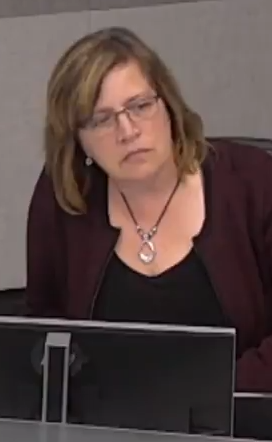 Ward 4 Councillor Shawna Stolte has put a good idea on the table – now the community has to join in and flesh this out. The bureaucrats need to lighten up a little and get creative as well. Stolte points out that the “motion is intended to encourage a realistic, longer term plan that will ensure safe “physical distancing” as well as strive for the balance that is needed to support physical exercise and mental health initiatives, by literally creating more space for people to get outside and breathe.
It’s an interesting idea – Stolte has done her part. Now it is up to the people who live on those streets to think about how they would change their streets.
Talk to your neighbours – write up your ideas and send them to the Councillor – at ward4@burlington.ca
Let’s see if this idea has any traction.
And let’s see how creative the folks in the Transportation Department can be.

 By Pepper Parr By Pepper Parr
April 17th, 2020
BURLINGTON, ON
City Council will learn from city staff what they expect the financial impacts of COVID-19 will be and seek Council’s endorsement of a three-month strategy that prioritizes which City services will be provided through to the end of June 2020.
Out of those deliberations will come a three-month work plan for the strategic management of the City budget and finances.
A statement from the administration seeks to assure City Council that staff remain committed to fiscal responsibility and accountability and are focused on offsetting all of the COVID-19 related City revenue losses to June 30, 2020 and are looking ahead past July 2020 to mitigate a shortfall at 2020 year-end.
A report detailing the impacts of the COVID-19 pandemic on the City’s budget will be presented. This report will include:
• estimated revenue impacts of $7.6 million to June 30, 2020
• estimated expenditure savings of $5.2 million to June 30, 2020
• cash flow projections to June 30, 2020
• future financial modelling to identify pressures, dependent on the length of the pandemic, and recovery scenarios.
Municipalities are required to approve a budget that is balanced, however, the City can have a shortfall or surplus in a given year. A shortfall can be offset by:
• using reserve funds
• increasing taxes in the next year; or
• reducing expenditures during the year of the anticipated shortfall.
Burlington is attempting to mitigate a shortfall at year-end.
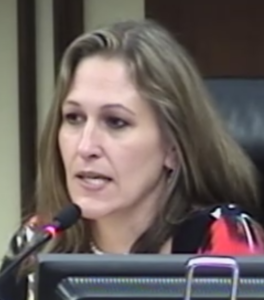 Mayor Marianne Meed Ward Mayor Marianne Meed Ward said: “Our City is currently in a good position thanks to savings we’ve acquired through our winter maintenance budget, the result of a light winter, and major tenders that came in under budget.
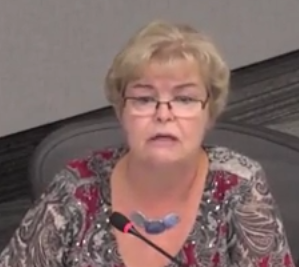 Joan Ford, Chief Financial Officer Joan Ford, Chief Financial Officer is the one who has to do the numbers juggling. Ms Ford and her team have always been conservative and cautious. She explains that: “In recognition of significant revenue losses such as transit fares, recreation programming and property tax deferrals, an expenditure restraint program was immediately implemented across the City to assist in mitigating the financial impacts.”
Will council listen or will they scour the reserve funds and look for ways to make up the shortfall from that source?
Monday is going to be a long day for city council – how deep their hands go into your pockets in the years ahead will be determined then.

 By Pepper Parr By Pepper Parr
April 17th, 2020
BURLINGTON, ON
The April 20 City Council meeting will begin at 9:30 a.m. instead of 6:30 p.m.
The media release said the early start was to provide residents with the opportunity to watch a live stream of the meeting at a more convenient time.
The agenda is very heavy – they couldn’t possibly get through it all during an evening session.
The public can view virtual Council meetings remotely using the City’s existing web streaming tool at www.burlington.ca/calendar.
 It will be the Mayor, the Clerk and the audio/visual technician only in the Council Chamber – the rest will be at home wearing headsets and participating virtually. While no delegations are currently permitted, written comments may be submitted to the City Clerk by email at clerks@burlington.ca.
Received written submissions will form part of the public record and will be distributed to members of Burlington City Council.
Will they be read?
Live delegation presentations give Councillors an opportunity to ask questions and to follow up – that vital part of the delegater being in the room is lost.
Council will consider a recommendation to allow virtual delegations from members of the public at Council meetings, beginning in May 2020.

 By Ray Rivers By Ray Rivers
April 17th, 2020
BURLINGTON, ON
It’s a mess.
Long term care homes are host to about half of all of Canada’s COVID-19 fatalities. Ontario has 626 nursing homes, a little over half are privately operated, a quarter non-profit, and the rest municipal. There are close to 80,000 beds in use and there is a waiting list almost half as long again.
The costs of long term care are co-funded between the province and the patient. In 2018 provincial funding totalled $4.28 billion, less that a tenth of the provincial health budget, which amounts to about $150 per resident a day. That is board, room, cleaning and care for a little over $50,000 per patient per year plus the patient’s co-fund.
There was this idea once that for that kind of money, one could book a year-long ocean cruise, and get everything except the medical care. But nobody ever thought that they might also get stuck, like the 4000 Canadians on some 70 cruise ships, as of late March this year, who can’t get off because of COVID 19.
 Quebec has called on the federal government to bring in the army’s medical corps to help with their lack of health care at long term facilities But Ontario is putting an ‘iron ring’ around its institutions according to its premier, who has promised to leave no stone unturned, spare no expense.… Quebec has called on the federal government to bring in the army’s medical corps to help with their lack of health care at long term facilities But Ontario is putting an ‘iron ring’ around its institutions according to its premier, who has promised to leave no stone unturned, spare no expense.…
Next week he finally will ban support staff from working in more than one long term facility, thereby eliminating a potential source of spread. But B.C. had brought in a similar regulation almost a month ago and Ontario had enacted a similar rule back during the SARS crisis. So why has it taken this long for Ford to act? Perhaps he empathized with the long term support staff, having to take on extra employment to make up for their miserable pay levels.
It’s not Ford’s fault that COVID 19 came to Canada and Ontario. The virus arrived here with travellers arriving first from China, then from other places. As the contagion got a foothold and spread, we remained calm on the advice of Canada’s chief medical officer.
 Dr. Teresa Tam: Chief Medical Officer of Health Dr. Tam told us that the risk to Canadians was minimal and there was no need for travel restrictions, quarantine or protective masks to reduce the risk of exposure. So today Ontario has had over 500 deaths and over half of those are in long term care.
But Ford’s record in this is anything but spotty clean. Jurisdictions, like South Korea, which have minimized the coronavirus casualties, have used extensive testing to identify, isolate and treat the infected. Ontario has the lowest record of testing in Canada, and that may explain why its infection numbers appear lower than they actually are – and why our death rate is so high.
Following the SARS crisis masks and other personal protection equipment (PPE) were stockpiled, but they got stale dated and eventually junked. But nobody, even in the previous administration, thought to rebuild the stockpile. So now Ford and his health minister are promising to fix this, even if late and too little.
Ford changed the labour laws in the province reducing sick leave days for employees and allowing employers to demand a medical certificate. In the early days of the epidemic this may have contributed to the virus spread, since sick employees would need to still go to their jobs to get paid, and those who didn’t needed to visit their doctor’s crowded offices for their medical certificate.
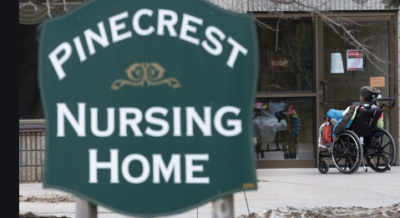 A nursing home in Bobcaygen where 29 patients in a 65 bed facility died of COVID19 But perhaps worst of all, when it comes to long term care the Ford government had stopped inspecting health and safety conditions in nursing homes as a matter of policy. These annual inspections are the only way the province had to ensure that a nursing establishment was meeting it’s health, safety and licensing requirements.
Inspections went from 100% in 2017, under the previous Liberal government, to almost zero last year. Is it any wonder infection has spread so rapidly?
Instead of an annual snap Inspection for all homes conducted during the previous government only 9 of 626 were inspected in 2019.
Unfortunately this brings back memories of another Conservative premier who rolled the dice, deregulating water safety. That ended up with 7 people dying and half of a town’s people sickened. That policy, like Ford’s decision on inspections, was ideological, about cost cutting, eliminating red tape and promoting deregulation.
Australia has a different take on long term care. Their system is national and publicly run under strict rules and inspections. Australians saw where this virus might be heading before anyone called it a pandemic and responded much faster and more effectively than Canada, even though their first case arrived two days after ours.
And their long term deaths have been low, making them a model for us to emulate in this country. In fact there have been twice as many COVID 19 deaths in Ontario’s long term care homes than among Australia’s entire population of 25 million. Clearly they are doing something right.
 The government of the day – Mike \Harries Tory’s failed the people of Walkerton. Doug Ford has told us that his wife’s mother is a patient at a Toronto nursing home. One has to wonder what she thinks. After all, his is the kind of subtle negligence which eventually came back to haunt former PC premier Mike Harris. We’ll see eventually if this is really an iron ring or just Mr. Ford’s Walkerton.
Nobody wants to criticize a political leader during a time of an unprecedented health crisis. Doug Ford rose up in everyone’s expectations with his early daily briefings, closing the schools, declaring a state of emergency and gradually locking down the province’s economy. It was comforting to see someone in charge.
He could have moved faster and shut down more non-essential workplaces earlier, like construction. And public transit across the province should have been shut down as it has been in other places where social distancing is impossible. Ford’s people should have embraced masks earlier, instead of simply regurgitating the mis-truths from the World Health Organization and Canada’s own Dr. Tam.
And he could have left the provincial parks open. After a month of lockdown people need to get out for some exercise and fresh air. It would be easier to social distance on a park trail or open field than a crowded sidewalk, wouldn’t it?
Lately Ford has pretty much run out of ‘breaking news’ for his daily press conferences. They’ve started to morph into poorly staged political rallies, as the Premier and his beleaguer health minister tell us how they are there for us and doing all they can. And watching the two of them in action confirms for me that the PC’s did the right thing in nominating Ford for the top job.
 Ontario Premier Doug Ford Ford recently got angry complaining about Ontario’s pathetic rate of COVID 19 testing. But then seriously, isn’t he the premier? We want Ford to succeed in fighting this epidemic. It’s in all of our interests regardless of any political stripe.
But we need to have faith and believe in our premier. And that means some straight talk instead of hype and empty promises. Ford could begin by recognizing what has gone wrong and assuring us that he has learned from his mistakes.

Ray Rivers writes weekly on both federal and provincial politics, applying his more than 25 years as a federal bureaucrat to his thinking. Rivers was a candidate for provincial office in Burlington where he ran against Cam Jackson in 1995, the year Mike Harris and the Common Sense Revolution swept the province.
Background links:
Long Term Care in Ontario – Ford Didn’t Protect Them – COVID 19 Spread in Ontario Nursing Homes –
Masks Destroyed – Long Term in Australia –

 By Staff By Staff
April 17th, 2020
BURLINGTON, ON
The Regional Public Health Unit releases updates on COVID-19 crisis up to and including Wednesday end of day on April 15, 2020:
Cases over time
34 COVID-19 cases reported to Halton Region Public Health since the last update (24 confirmed + 10 probable)
393 COVID-19 cases reported to Halton Region Public Health to date (350 confirmed + 43 probable)
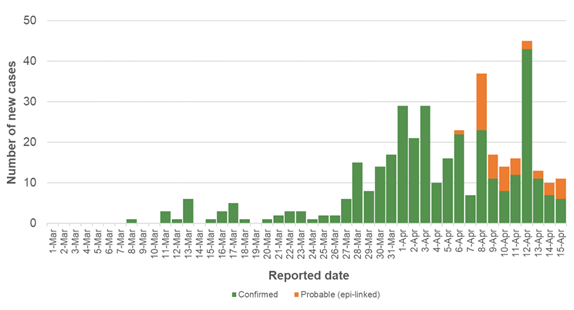 COVID-19 cases, by reported date, Halton Region, Mar. 1-Apr. 15, 2020
Figure shows the 393 COVID-19 cases that had been reported to Halton Region Public Health by end of the day on April 15. All cases have been graphed according to the date they were reported, which is often several days after the onset of symptoms. Among the cases in this figure, 34 were reported since the last update (meaning they were reported between April 13 and April 15, 2020).
Individuals who are lab-confirmed cases are shown in green. Individuals who are probable cases are shown in orange. Probable cases are epi-linked cases, which means they are presumed to have COVID-19 because they are symptomatic close contacts of cases or returning travelers who have COVID-19 symptoms.
Case demographics
67 cases live in an institution (17% of all cases)
55 cases work in health care (14% of all cases)
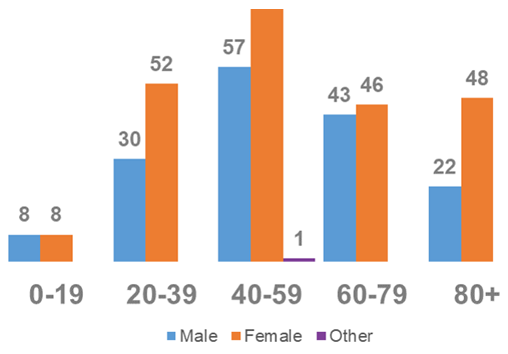 COVID-19 cases, by age and sex, Halton Region, 2020 Figure shows that by end of the day on April 15, the most COVID-19 cases were among Halton residents aged 40-59 (with 136 cases, or 35%). 232 of the 393 cases (59%) were female.
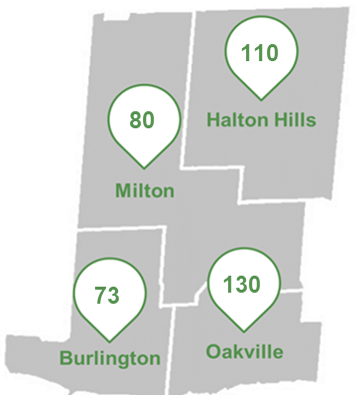 COVID-19 cases, by municipality of residence, Halton Region, 2020 Figure shows that by end of the day on April 15, the greatest number of COVID-19 cases were among residents of Oakville (with 131 cases, or 33%). Please note this figure shows counts, and therefore does not take into account the different population sizes or age structures of the four municipalities. Counts in municipalities can also be inflated by outbreaks that have occurred within institutions in their boundaries.
Case exposure source
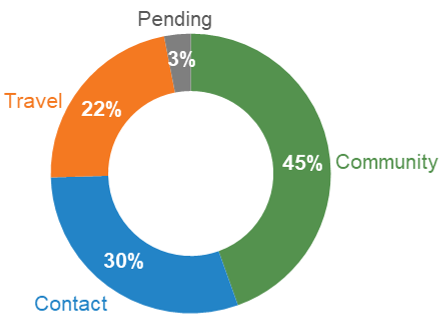 Percentage of COVID-19 cases, by exposure source, Halton Region, 2020 Figure shows that by end of the day on April 15, 175 of Halton Region’s COVID-19 cases (45%) had no known travel or contact history, and therefore were believed to have acquired the virus within Ontario, making them community cases. 118 cases (30%) had contact with a confirmed case that was believed to be the source of their infection. 88 cases (22%) had a history of travel that was believed to have been the source of their infection. Information on exposure source was pending for the remaining 12 cases (3%).
Case outcomes
52 cases who have ever been hospitalized to date (27 listed as currently in hospital)
146 cases who have recovered to date
12 cases who have died to date (7 of the deceased were institutional residents)
Institutional outbreaks
0 confirmed institutional outbreaks of COVID-19 reported to Halton Region Public Health since the last update
7 confirmed institutional outbreaks of COVID-19 reported to Halton Region Public Health to date
Among the seven confirmed institutional outbreaks reported to date, four (57%) have been in retirement homes, while two occurred in long-term care homes and one occurred in a hospital. None of the confirmed outbreaks were reported since the last update. None of the confirmed outbreaks have yet been declared over. Please note these counts do not include any suspected outbreaks that remain under investigation.
Lab testing
6,000 Halton residents are known to have been tested for COVID-19 to date
Comparison to Ontario
8,961 total confirmed COVID-19 cases reported in Ontario to date
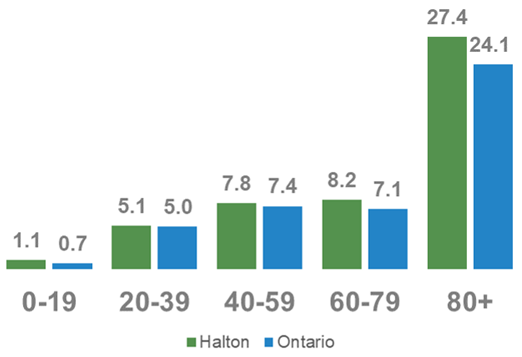 Age-specific rates of COVID-19 (per 10,000 population), Halton Region and Ontario, 2020 Figure 5 shows age-specific rates of COVID-19 for Halton and Ontario. Rates take into account the population size of each age group to make it possible to compare between different areas. Halton’s age-specific rates are similar to the provincial rates for all age groups (for example, while Halton has 27.4 cases per 10,000 residents aged 80+, this is not statistically significantly different from the 24.1 cases per 10,000 residents aged 80+ in Ontario). It is important to note that these rates will fluctuate as numbers increase throughout the pandemic, and that differences between age groups may reflect differences in the likelihood of developing symptoms and being tested.
Data limitations and data sources
Halton case data: integrated Public Health Information System (iPHIS), extracted at 7:00 AM on April 16, 2020, to reflect data entered by the end of the day on April 15, 2020
Halton lab data: COVID Data Information System, extracted on April 16, 2020.
Ontario case data: Public Health Ontario, Epidemiologic Summary, COVID-19 in Ontario: January 15, 2020 to April 15, 2020, posted on April 16, 2020 to https://www.ontario.ca/page/2019-novel-coronavirus
Denominators for Halton and Ontario age-specific rates: Population projections [2020], IntelliHEALTH Ontario, extracted on April 8, 2020.
Data notes
All cases of diseases of public health significance diagnosed in Ontario are entered into iPHIS by local public health units. iPHIS is the Integrated Public Health Information System. It is a dynamic disease reporting system which allows ongoing updates to data previously entered. As a result, data extracted from iPHIS represent a snapshot at the time of extraction and may differ from previous or subsequent reports as data are updated.
The data only represent cases reported to public health and recorded in iPHIS. As a result, all counts will be subject to varying degrees of underreporting due to a variety of factors, such as disease awareness and medical care seeking behaviours, which may depend on severity of illness, clinical practice, changes in laboratory testing, and reporting behaviours.
Cases are included if their “diagnosing health unit” in iPHIS is Halton Region, which means counts include only individuals whose primary residence is in Halton Region. The case may not necessarily have been managed by Halton Region, if they were temporarily residing elsewhere during their case management period. Cases managed by Halton Region who normally live elsewhere but who were managed by Halton Region staff because they were temporarily residing in Halton during their case management period have not been included.
Cases for which the Disposition Status in iPHIS was reported as ENTERED IN ERROR, DOES NOT MEET DEFINITION, DUPLICATE-DO NOT USE, or any variation on these values have been excluded.
Figure 1 distinguishes between lab-confirmed and probable cases. Since April 7, probable cases are defined as epi-linked cases, meaning they are symptomatic close contacts of cases or returning travelers who have COVID-19 symptoms and therefore are presumed to have COVID-19. All other figures and numbers include both confirmed and probable cases combined.
In subsequent reports, counts in Figure 1 may increase as cases are added from past dates due to delayed data entry or new arrival of lab results. To minimize such retrospective changes, cases have been graphed according to case reported date, which does not reflect onset of illness.
Cases are considered to live in an institution if the name of a facility (e.g. a long-term care home, retirement home, prison) has been entered for their address in iPHIS.
Cases are considered to work in health care if they are known to have an occupation that involves caring for patients, e.g. physician, nurse, occupational therapist, recreational therapist, chiropractor, paramedic, midwife, orderly, etc.
Exposure type is determined by examining the exposure and risk factor fields from iPHIS to determine whether a case travelled, was a contact of a case or neither. A hierarchy has been applied as follows: Travel-related > Close contact of a confirmed case > Neither (indicating community acquisition) > Information pending.
Case outcomes (hospitalizations, recovery, deaths) reflect the latest available information reported to Halton Region Public Health and recorded in iPHIS by the extraction time.
Institutional outbreaks include outbreaks of COVID-19 in settings such as long-term care homes, retirement homes, hospitals, and prisons.
Lab testing data reflects only lab tests that have been reported to Halton Region Public Health and entered into CDIS. There may be more residents who have been tested but not reported to Public Health.
Related Regional Health reports
April 9th data
April 12th data

|
|
 By Staff
By Staff





























 Ray Rivers writes regularly on both federal and provincial politics, applying his more than 25 years as a federal bureaucrat to his thinking. Rivers was once a candidate for provincial office in Burlington. He was the founder of the Burlington citizen committee on sustainability at a time when climate warming was a hotly debated subject. Ray has a post graduate degree in economics that he earned at the University of Ottawa. Tweet @rayzrivers
Ray Rivers writes regularly on both federal and provincial politics, applying his more than 25 years as a federal bureaucrat to his thinking. Rivers was once a candidate for provincial office in Burlington. He was the founder of the Burlington citizen committee on sustainability at a time when climate warming was a hotly debated subject. Ray has a post graduate degree in economics that he earned at the University of Ottawa. Tweet @rayzrivers


















 Mayor Marianne Meed Ward cautions people. “As the weather gets warmer we know it will be harder to follow the provincial emergency orders, and the directives from Burlington City Hall. But we must continue to stay apart, and stay in our own neighbourhoods, so we can get through this sooner. Please resist the urge to congregate in groups, stay 6 ft. away from anyone you don’t live with and please stay in your own neighbourhood and local parks for your walks.
Mayor Marianne Meed Ward cautions people. “As the weather gets warmer we know it will be harder to follow the provincial emergency orders, and the directives from Burlington City Hall. But we must continue to stay apart, and stay in our own neighbourhoods, so we can get through this sooner. Please resist the urge to congregate in groups, stay 6 ft. away from anyone you don’t live with and please stay in your own neighbourhood and local parks for your walks. This major donation is intended to address the needs of vulnerable people and families including those experiencing homelessness and poverty, isolated seniors, people with disabilities and other marginalized communities.
This major donation is intended to address the needs of vulnerable people and families including those experiencing homelessness and poverty, isolated seniors, people with disabilities and other marginalized communities. In Burlington, the Paletta family’s donation will support Burlington Foundation’s
In Burlington, the Paletta family’s donation will support Burlington Foundation’s 






 A resident tells us that it was his wife’s turn to take the bottles and cans in; having checked on line she learned that the only Beer Store accepting returns was the one at Upper Middle Road and Appleby Line.
A resident tells us that it was his wife’s turn to take the bottles and cans in; having checked on line she learned that the only Beer Store accepting returns was the one at Upper Middle Road and Appleby Line. As well, there was an ability to simply drop off returns as a donation to the Joseph Brant Hospital. This helped to cut down on social distancing and the line up! Brilliant!
As well, there was an ability to simply drop off returns as a donation to the Joseph Brant Hospital. This helped to cut down on social distancing and the line up! Brilliant!








 But more important than the two is the street.
But more important than the two is the street.








 Quebec has called on the federal government to bring in the army’s medical corps to help with their lack of health care at long term facilities But Ontario is putting an ‘iron ring’ around its institutions according to its premier, who has promised to leave no stone unturned, spare no expense.…
Quebec has called on the federal government to bring in the army’s medical corps to help with their lack of health care at long term facilities But Ontario is putting an ‘iron ring’ around its institutions according to its premier, who has promised to leave no stone unturned, spare no expense.…












